Paul van Yperen's Blog, page 165
April 1, 2021
Uma Thurman
Blonde and blue-eyed American actress Uma Thurman (1970) is best known for her roles in Quentin Tarantino's Pulp Fiction (1994), Kill Bill: Vol. 1 (2003) and Kill Bill: Vol. 2 (2004) and was hailed as Tarantino's muse. Furthermore, she starred in a wide variety of films, from romantic comedies and dramas to science fiction and action films.
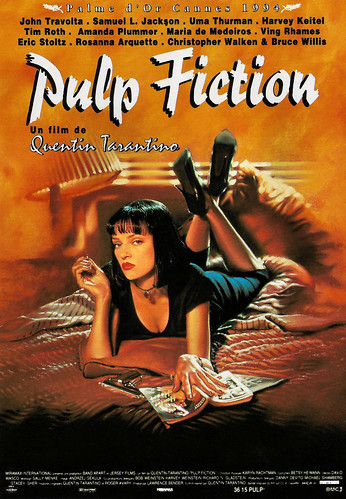
French postcard by Sonis, no. C. 492. Photo: Bac Films. Uma Thurman on the French poster for Pulp Fiction (Quentin Tarantino, 1994). Caption: Affiche du film.
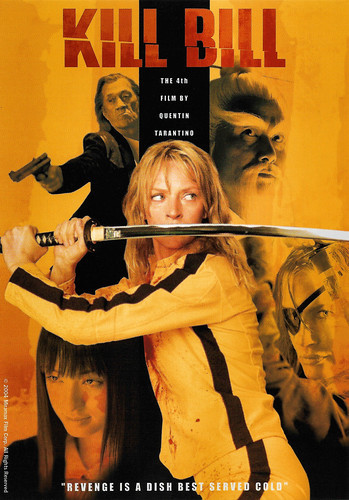
British postcard by Pyramid Posters, Leicester, no. PC 9471. Photo: Miramax Films / A Band Apart. Uma Thurman (montage) in Kill Bill (Quentin Trantino, 2003). Caption: The 4th film by Quentin Tarantino. "Revenge is a dish best served cold".
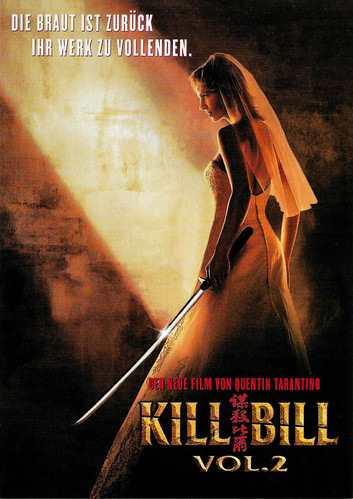
German postcard by Edgar Medien. Photo: Buena Vista International. Uma Thurman in Kill Bill: Vol. 2 (Quentin Tarantino, 2004). Caption: The bride is back to finish her work.
An homage to Botticelli's The Birth of Venus
Uma Karuna Thurman was born in 1970 in Boston, Massachusetts, into a highly unorthodox and internationally-minded family. She is the daughter of Nena Thurman (née Birgitte Caroline von Schlebrügge), a fashion model and socialite who now runs a mountain retreat, and of Robert Thurman (Robert Alexander Farrar Thurman), a professor and academic who is one of the nation's foremost Buddhist scholars.
Uma grew up in Amherst, Massachusetts, where her father worked at Amherst College. Thurman's household was one in which The Dalai Lama was an occasional guest; she and her siblings all have names deriving from Buddhist mythology; and Middle American behaviour was little understood, much less pursued. And so it was that the young Thurman confronted childhood with an odd name and eccentric home life - and nature seemingly conspired against her as well.
She is six feet tall, and from an early age Uma towered over everyone else in her class. The family constantly relocated, making the gangly, socially inept Thurman perpetually the new kid in class. The result was an exceptionally awkward, self-conscious, lonely, and alienated childhood. Unsurprisingly, the young Thurman enjoyed making believe she was someone other than herself, and so thrived at acting in school plays.
This interest, and her lanky frame, perfect for modeling, led the 15-year-old Thurman to New York City for high school and modeling work (including a layout in Glamour Magazine) as she sought acting roles. The roles soon came.
She made her film debut in the teen thriller Kiss Daddy Goodnight (Peter Ily Huemer, 1987). It was followed by Terry Gilliam's interesting box office bomb, The Adventures of Baron Munchausen (1988), starring John Neville. She made a brief appearance as the goddess Venus, and during her entrance, she briefly appears nude, in an homage to Botticelli's 'The Birth of Venus'.
Then followed her breakthrough in Dangerous Liaisons (Stephen Frears, 1988) from a screenplay by Christopher Hampton, which was based on the 1782 French novel 'Les liaisons dangereuses' by Pierre Choderlos de Laclos. The period romantic drama, starring Glenn Close, John Malkovich, and Michelle Pfeiffer , brought much attention to her unorthodox sensuality. Her performance intriguingly combined innocence and worldliness. The weird, gangly girl became a sex symbol virtually overnight.

American postcard by Fotofolio, New York, N.Y., no. JC13. Photo: John Chan, 1988.
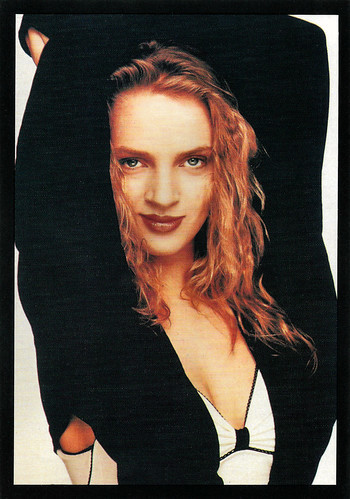
Vintage postcard, no. 2068. Caption: Sweet 'n sexy.
That most unorthodox of all gangster's molls
Uma Thurman continued to be offered good roles in Hollywood pictures into the early 1990s, the least commercially successful but probably best-known of which was her smoldering, astonishingly-adult performance as June, Henry Miller's wife, in Henry & June (Philip Kaufman, 1990), the first film to actually receive the dreaded NC-17 rating in the USA.
After a celebrated start, Thurman's career stalled in the early 1990s with films such as the mediocre Mad Dog and Glory (John McNaughton, 1993) with Robert De Niro . Worse, her first starring role was in Even Cowgirls Get the Blues (Gus Van Sant, 1993), which had endured a tortured journey from cult-favorite book to big-budget film and was a critical and financial debacle.
Uma bounced back with a brilliant performance as Mia Wallace, that most unorthodox of all gangster's molls, in Tarantino's lauded, hugely successful Pulp Fiction (Quentin Tarantino, 1994). For her role, Thurman was nominated for the Academy Award, the BAFTA Award, and the Golden Globe Award for Best Supporting Actress. She took little advantage of her new-found fame by choosing not to do any big-budget films for the next three years.
She starred in the independent period drama A Month by the Lake (John Irvin, 1995) opposite Vanessa Redgrave and Edward Fox, and supporting roles in which she has lent some glamorous presence to a mixed batch of films, such as Beautiful Girls (Ted Demme, 1996) with Matt Dillon , and The Truth About Cats & Dogs (Michael Lehmann, 1996).
She played supervillain Poison Ivy in the reviled Batman & Robin (Joel Schumacher, 1997) with George Clooney, and Emma Peel opposite Ralph Fiennes as John Steed in a remake of The Avengers (Jeremiah Chechik, 1998). She worked with Woody Allen and Sean Penn on Sweet and Lowdown (1999) and starred in Richard Linklater's drama Tape (2001) opposite husband Ethan Hawke. Thurman also won a Golden Globe award for her turn in the made-for-television film Hysterical Blindness (2002), directed by Mira Nair.
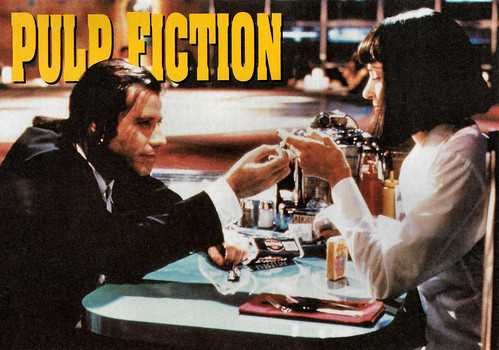
Vintage postcard, no. 2102. John Travolta and Uma Thurman in Pulp Fiction (Quentin Tarantino, 1994). Caption: John n Uma at table.
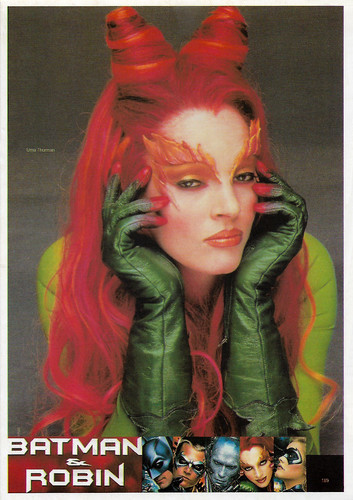
Vintage postcard in the Cinemascope Collection, no. 65. Uma Thurman as Poison Ivy in Batman & Robin (Joel Schumacher, 1997).
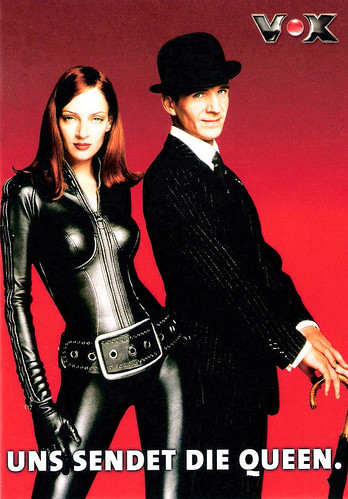
German postcard by Edgar Medien. Photo: Vox. Uma Thurman and Ralph Fiennes in The Avengers (Jeremiah S. Chechik, 1998). Caption: Uns sendet die Queen.
Revenge on a team of assassins
A return to the mainstream spotlight came when Uma Thurman re-teamed with Quentin Tarantino for Kill Bill: Vol. 1 (2003). The two had dreamed up this two-part revenge action film on the set of Pulp Fiction (1994). Thurman starred as the Bride, who swears revenge on a team of assassins (Lucy Liu, Michael Madsen, Daryl Hannah, and Vivica A. Fox) and their leader, Bill (David Carradine) after they try to kill her and her unborn child.
She then turned up in the John Woo cautioner Paycheck (2003) that same year. The renewed attention was not altogether welcome because Thurman was dealing with the break-up of her marriage with Hawke at about this time. Thurman handled the situation with grace, however, and took her surging popularity in stride.
She garnered critical acclaim for her work in Kill Bill: Vol. 2 (Quentin Tarantino, 2004) and was hailed as Tarantino's muse. The two Kill Bill films brought her two additional Golden Globe Award nominations.
Thurman reunited with Pulp Fiction dance partner John Travolta for the Get Shorty (Barry Sonnenfeld, 1995) sequel Be Cool (F. Gary Gray, 2005). Despite a lukewarm critical reception, the film grossed US$95 million.
She played Ulla in the remake of The Producers (Susan Stroman, 2005). In 2006, she was made a Knight of the Order of Arts and Letters (Chevalier De l'Ordre Des Arts Et Des Lettres) by France. For her five-episode role in the musical TV series Smash (2012), Thurman received a Primetime Emmy Award nomination for Outstanding Guest Actress in a Drama Series.
Her later films include Lars von Trier's Nymphomaniac (2013) and The House That Jack Built (2018). She made her Broadway debut in Beau Willimon's political drama 'The Parisian Woman' (2017-2018) at Hudson Theatre. For her role, she won the Broadway.com Audience Award for Favorite Leading Actress in a Play.
In 2018, in a New York Times interview, Thurman revealed that Harvey Weinstein had sexually assaulted her in 1994. Uma Thurman was briefly married to Gary Oldman, from 1990 to 1992. In 1998, she married Ethan Hawke, her co-star in the offbeat futuristic thriller Gattaca (Andrew Niccol, 1997). The couple has two children, Levon and Maya. Hawke and Thurman filed for divorce in 2004.
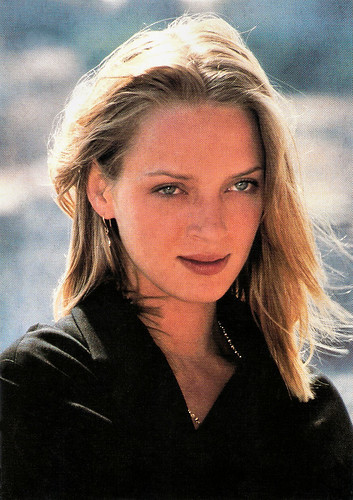
British postcard by Anabas, Essex, no. AP578, 1997.
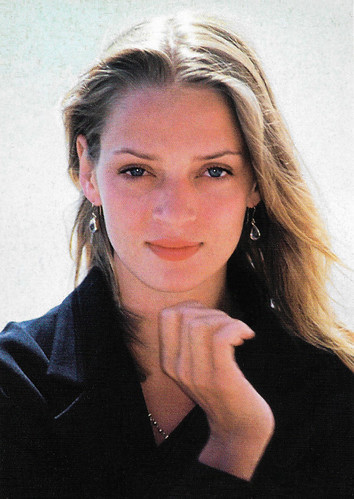
British postcard by Pyramid, Leicester, no. PC 8457, 1999.
Sources: Wikipedia and .

French postcard by Sonis, no. C. 492. Photo: Bac Films. Uma Thurman on the French poster for Pulp Fiction (Quentin Tarantino, 1994). Caption: Affiche du film.

British postcard by Pyramid Posters, Leicester, no. PC 9471. Photo: Miramax Films / A Band Apart. Uma Thurman (montage) in Kill Bill (Quentin Trantino, 2003). Caption: The 4th film by Quentin Tarantino. "Revenge is a dish best served cold".

German postcard by Edgar Medien. Photo: Buena Vista International. Uma Thurman in Kill Bill: Vol. 2 (Quentin Tarantino, 2004). Caption: The bride is back to finish her work.
An homage to Botticelli's The Birth of Venus
Uma Karuna Thurman was born in 1970 in Boston, Massachusetts, into a highly unorthodox and internationally-minded family. She is the daughter of Nena Thurman (née Birgitte Caroline von Schlebrügge), a fashion model and socialite who now runs a mountain retreat, and of Robert Thurman (Robert Alexander Farrar Thurman), a professor and academic who is one of the nation's foremost Buddhist scholars.
Uma grew up in Amherst, Massachusetts, where her father worked at Amherst College. Thurman's household was one in which The Dalai Lama was an occasional guest; she and her siblings all have names deriving from Buddhist mythology; and Middle American behaviour was little understood, much less pursued. And so it was that the young Thurman confronted childhood with an odd name and eccentric home life - and nature seemingly conspired against her as well.
She is six feet tall, and from an early age Uma towered over everyone else in her class. The family constantly relocated, making the gangly, socially inept Thurman perpetually the new kid in class. The result was an exceptionally awkward, self-conscious, lonely, and alienated childhood. Unsurprisingly, the young Thurman enjoyed making believe she was someone other than herself, and so thrived at acting in school plays.
This interest, and her lanky frame, perfect for modeling, led the 15-year-old Thurman to New York City for high school and modeling work (including a layout in Glamour Magazine) as she sought acting roles. The roles soon came.
She made her film debut in the teen thriller Kiss Daddy Goodnight (Peter Ily Huemer, 1987). It was followed by Terry Gilliam's interesting box office bomb, The Adventures of Baron Munchausen (1988), starring John Neville. She made a brief appearance as the goddess Venus, and during her entrance, she briefly appears nude, in an homage to Botticelli's 'The Birth of Venus'.
Then followed her breakthrough in Dangerous Liaisons (Stephen Frears, 1988) from a screenplay by Christopher Hampton, which was based on the 1782 French novel 'Les liaisons dangereuses' by Pierre Choderlos de Laclos. The period romantic drama, starring Glenn Close, John Malkovich, and Michelle Pfeiffer , brought much attention to her unorthodox sensuality. Her performance intriguingly combined innocence and worldliness. The weird, gangly girl became a sex symbol virtually overnight.

American postcard by Fotofolio, New York, N.Y., no. JC13. Photo: John Chan, 1988.

Vintage postcard, no. 2068. Caption: Sweet 'n sexy.
That most unorthodox of all gangster's molls
Uma Thurman continued to be offered good roles in Hollywood pictures into the early 1990s, the least commercially successful but probably best-known of which was her smoldering, astonishingly-adult performance as June, Henry Miller's wife, in Henry & June (Philip Kaufman, 1990), the first film to actually receive the dreaded NC-17 rating in the USA.
After a celebrated start, Thurman's career stalled in the early 1990s with films such as the mediocre Mad Dog and Glory (John McNaughton, 1993) with Robert De Niro . Worse, her first starring role was in Even Cowgirls Get the Blues (Gus Van Sant, 1993), which had endured a tortured journey from cult-favorite book to big-budget film and was a critical and financial debacle.
Uma bounced back with a brilliant performance as Mia Wallace, that most unorthodox of all gangster's molls, in Tarantino's lauded, hugely successful Pulp Fiction (Quentin Tarantino, 1994). For her role, Thurman was nominated for the Academy Award, the BAFTA Award, and the Golden Globe Award for Best Supporting Actress. She took little advantage of her new-found fame by choosing not to do any big-budget films for the next three years.
She starred in the independent period drama A Month by the Lake (John Irvin, 1995) opposite Vanessa Redgrave and Edward Fox, and supporting roles in which she has lent some glamorous presence to a mixed batch of films, such as Beautiful Girls (Ted Demme, 1996) with Matt Dillon , and The Truth About Cats & Dogs (Michael Lehmann, 1996).
She played supervillain Poison Ivy in the reviled Batman & Robin (Joel Schumacher, 1997) with George Clooney, and Emma Peel opposite Ralph Fiennes as John Steed in a remake of The Avengers (Jeremiah Chechik, 1998). She worked with Woody Allen and Sean Penn on Sweet and Lowdown (1999) and starred in Richard Linklater's drama Tape (2001) opposite husband Ethan Hawke. Thurman also won a Golden Globe award for her turn in the made-for-television film Hysterical Blindness (2002), directed by Mira Nair.

Vintage postcard, no. 2102. John Travolta and Uma Thurman in Pulp Fiction (Quentin Tarantino, 1994). Caption: John n Uma at table.

Vintage postcard in the Cinemascope Collection, no. 65. Uma Thurman as Poison Ivy in Batman & Robin (Joel Schumacher, 1997).

German postcard by Edgar Medien. Photo: Vox. Uma Thurman and Ralph Fiennes in The Avengers (Jeremiah S. Chechik, 1998). Caption: Uns sendet die Queen.
Revenge on a team of assassins
A return to the mainstream spotlight came when Uma Thurman re-teamed with Quentin Tarantino for Kill Bill: Vol. 1 (2003). The two had dreamed up this two-part revenge action film on the set of Pulp Fiction (1994). Thurman starred as the Bride, who swears revenge on a team of assassins (Lucy Liu, Michael Madsen, Daryl Hannah, and Vivica A. Fox) and their leader, Bill (David Carradine) after they try to kill her and her unborn child.
She then turned up in the John Woo cautioner Paycheck (2003) that same year. The renewed attention was not altogether welcome because Thurman was dealing with the break-up of her marriage with Hawke at about this time. Thurman handled the situation with grace, however, and took her surging popularity in stride.
She garnered critical acclaim for her work in Kill Bill: Vol. 2 (Quentin Tarantino, 2004) and was hailed as Tarantino's muse. The two Kill Bill films brought her two additional Golden Globe Award nominations.
Thurman reunited with Pulp Fiction dance partner John Travolta for the Get Shorty (Barry Sonnenfeld, 1995) sequel Be Cool (F. Gary Gray, 2005). Despite a lukewarm critical reception, the film grossed US$95 million.
She played Ulla in the remake of The Producers (Susan Stroman, 2005). In 2006, she was made a Knight of the Order of Arts and Letters (Chevalier De l'Ordre Des Arts Et Des Lettres) by France. For her five-episode role in the musical TV series Smash (2012), Thurman received a Primetime Emmy Award nomination for Outstanding Guest Actress in a Drama Series.
Her later films include Lars von Trier's Nymphomaniac (2013) and The House That Jack Built (2018). She made her Broadway debut in Beau Willimon's political drama 'The Parisian Woman' (2017-2018) at Hudson Theatre. For her role, she won the Broadway.com Audience Award for Favorite Leading Actress in a Play.
In 2018, in a New York Times interview, Thurman revealed that Harvey Weinstein had sexually assaulted her in 1994. Uma Thurman was briefly married to Gary Oldman, from 1990 to 1992. In 1998, she married Ethan Hawke, her co-star in the offbeat futuristic thriller Gattaca (Andrew Niccol, 1997). The couple has two children, Levon and Maya. Hawke and Thurman filed for divorce in 2004.

British postcard by Anabas, Essex, no. AP578, 1997.

British postcard by Pyramid, Leicester, no. PC 8457, 1999.
Sources: Wikipedia and .
Published on April 01, 2021 22:00
March 31, 2021
Cinema-Illustrazione, Part 1
The popular Italian magazine Cinema-Illustrazione was founded in 1930. It originated from the journal Illustrazione, which started in 1926. From 1930 on, it only focussed on cinema. Among the editors was the future screenwriter Cesare Zavattini. The magazine offered bios of popular Hollywood stars and lots of glamour photos.
Cinema-Illustrazione
also published a glamorous postcard series of Hollywood stars. Today EFSP presents the first of two posts on these cards. The magazine stopped appearing in September 1939.
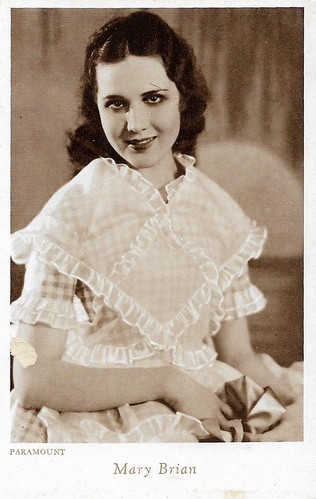
Italian postcard by Cinema-Illustrazione, Milano, series 1, no. 1. Photo: Paramount.
Mary Brian (1906-2002) was an American actress and film star with dark brown curls and blue/gray eyes, who made the transition from silent films to sound films. She was dubbed 'The Sweetest Girl in Pictures'.
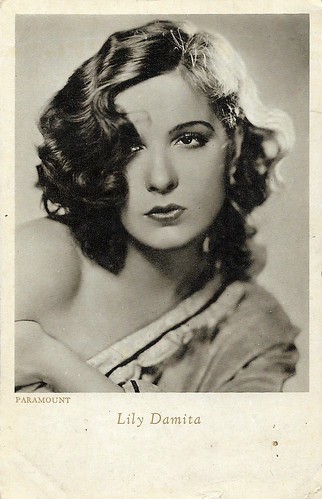
Italian postcard by Cinema-Illustrazione, Milano, Series 1, no. 3. Photo: Paramount.
Beautiful and seductive French actress Lily Damita (1902-1994) appeared in 33 French, Austrian, and Hollywood films between 1922 and 1937. Her marriage with Errol Flynn was rather tempestuous and led to her nickname 'Dynamita'.
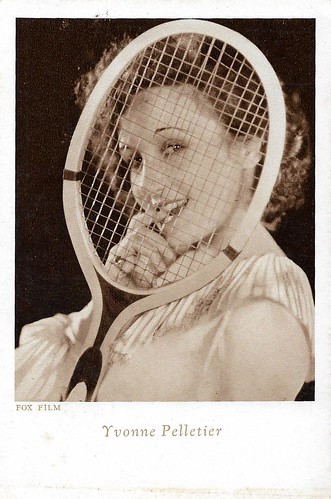
Italian postcard by Cinema-Illustrazione, Milano, Series 1, no. 4. Photo: Fox Film.
Yvonne Pelletier (1915-1995) was a Canadian film actress. She was a child actress in the 1920s and had a limited career in 1930s American cinema. This postcard may refer to her pre-Code Fox film Young Sinners (John G. Blystone, 1931) starring Thomas Meighan and Hardie Albright.
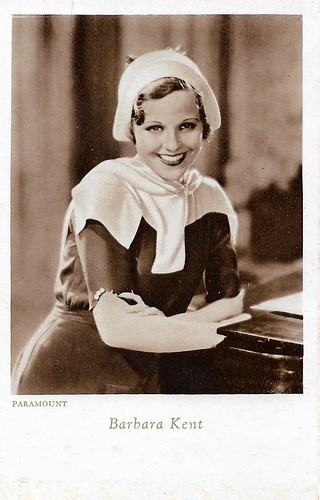
Italian postcard by Cinema-Illustrazione, Milano, series 1, no. 6. Photo: Paramount.
Barbara Kent (1907-2011) was an American-Canadian actress of 1920s and 1930s American cinema, known for e.g. Flesh and the Devil (1926), No Man's Law (1927), Lonesome (1928), Feet First (1930), Indiscreet (1931), Emma (1932), and Oliver Twist (1933).
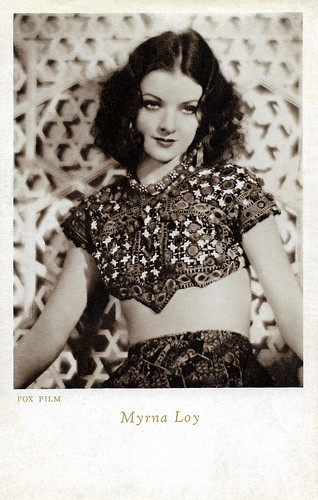
Italian postcard by Cinema-Illustrazione, Milano, Series 1, no. 7. Photo: Fox Film. Myrna Loy in Isle of Escape (Howard Bretherton, 1930).
Myrna Loy (1905-1993) was an American film, television, and stage actress. She was originally typecast in exotic roles, often as a vamp or a woman of Asian descent, but her career prospects improved greatly following her portrayal of Nora Charles in The Thin Man (W.S. Van Dyke, 1934). Suddenly she was 'Queen of the Movies' and remained so until the late 1940s.
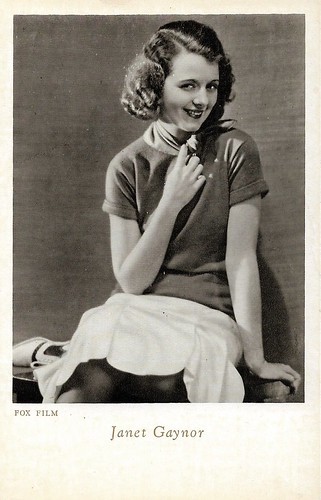
Italian postcard by Cinema-Illustrazione, Milano, Series 1, no. 8. Photo: Fox Film.
Petite Janet Gaynor (1906-1984) was the innocent-eyed, round-faced Hollywood star who won the first Academy Award for best actress for her roles in three silent films. She went on to become a leading performer in talking pictures and was one of the most popular Hollywood leading ladies in the 1920s and 1930s. By 1934 she was receiving a yearly salary of $252,583 from Fox, making her Hollywood's most highly paid actress.
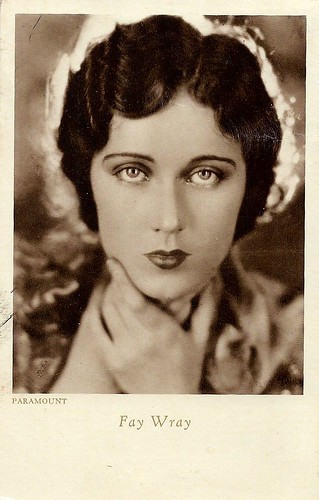
Italian postcard by Cinema-Illustrazione, Milano, series 1, no. 9. Photo: Paramount.
Canadian-born American actress Fay Wray (1907-2004) attained international recognition as the first 'scream queen' in a series of horror films during the early 1930s. Through an acting career that spanned nearly six decades, Wray is best known as Ann Darrow, the girl held in the hand of King Kong (1933). Two days after her death, the lights of the Empire State Building, the location of King Kong's climax scene, were dimmed for 15 minutes in memory of the "beauty who charmed the beast".
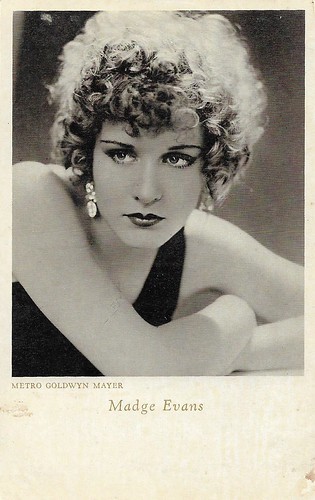
Italian postcard by Cinema-Illustrazione, Milano, Series 1, no. 10. Photo: Metro-Goldwyn-Mayer.
Lovely Madge Evans (1909-1981) was an American stage and film actress, who often played the 'nice' girl in Hollywood films of the 1930s. She began her career as a child performer and model, starting with Fairy Soap commercials at the age of two.
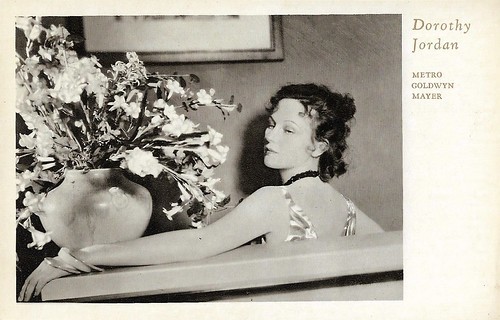
Italian postcard by Cinema-Illustrazione, Milano, series 1, no. 12. Photo: Metro-Goldwyn-Mayer.
American film actress Dorothy Jordan (1906-1988) emerged at the start of the talkies. She made her film debut as Mary Pickford's sister in Sam Taylor's The Taming of the Shrew (1929). Until 1933 Jordan played the female lead in various films for different studios. These included Min and Bill (1930) with Wallace Beery and Marie Dressler and The Cabin in the Cotton (1932) with Bette Davis. In 1933 Jordan left the film industry to marry film producer and director Merian C. Cooper.
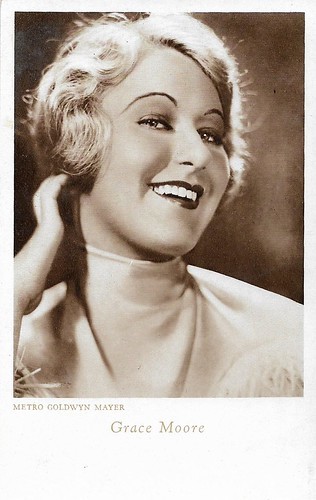
Italian postcard. Cinema-Illustrazione, Milano, Series 1, no. 13. Photo: Metro-Goldwyn-Mayer.
Grace Moore (1898-1947) was an internationally famous star of the Metropolitan Opera and Broadway. During the 1930s, she also starred in several Hollywood musicals. She was nominated for an Oscar for One Night of Love (1934) and was the subject of the biopic So This is Love (1953), in which Kathryn Grayson portrayed the "Tennessee Nightingale", as Grace was called. She died tragically in an airplane crash in 1947 at the height of her career.
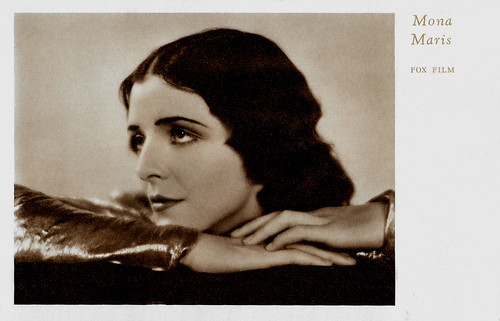
Italian postcard by Cinema-Illustrazione, Milano, Series 1, no. 14. Photo: Fox Film.
Sultry, sleepy-eyed Argentine brunette Mona Maris (1903-1991) appeared in both European and Hollywood silent films. After the arrival of sound, she starred in a string of Spanish-language versions of American films.
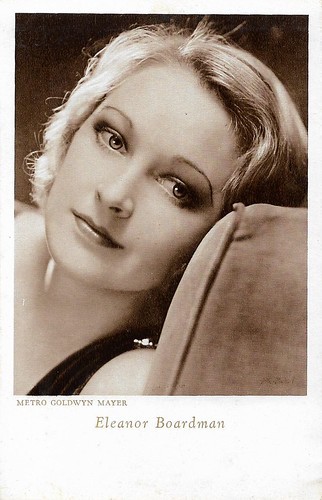
Italian postcard by Cinema-Illustrazione, Milano, series 1, no. 15. Photo: Metro-Goldwyn-Mayer.
Eleanor Boardman (1898-1991) was an American stage and silent screen actress, famous for King Vidor's The Crowd (1928), one of the best late American silent movies.
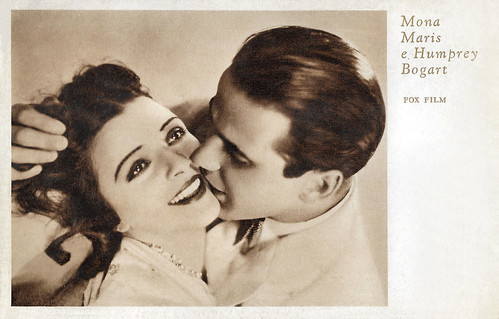
Italian postcard by Cinema-Illustrazione, Milano, Series 1, no. 16. Photo: Fox Film. Mona Maris and Humphrey Bogart in A Devil with Women (Irving Cummings, 1930).
Humphrey Bogart (1899-1957) is an icon of Hollywood cinema. His private detectives, Sam Spade in The Maltese Falcon (1941) and Phillip Marlowe in The Big Sleep (1946), became the models for detectives in other Film-Noirs. Bogart and 19-year-old Lauren Bacall fell in love when they filmed To Have and Have Not (1944), the first of a series of films together. He won the best actor Oscar for The African Queen (1951). He was also nominated for Casablanca (1942) and as Captain Queeg in Mutiny on the Caine (1954).
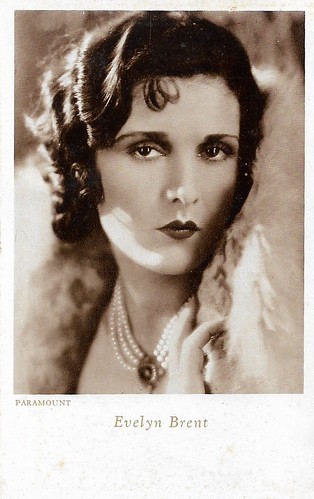
Italian postcard by Cinema-Illustrazione, Milano, series 1, no. 17. Photo: Paramount.
Evelyn Brent (1899-1975) was an American actress of the silent screen. Josef von Sternberg paved the way for her to become a top star through her role of the prostitute Feathers in Underworld (1927).
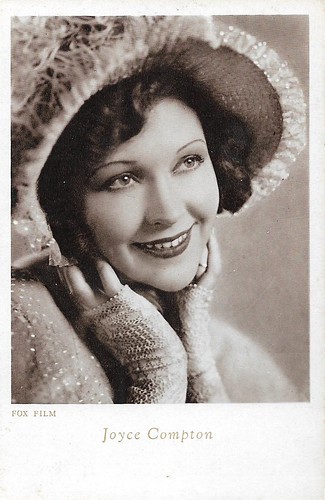
Italian postcard by Cinema-Illustrazione, Milano, series 1, no. 34. Photo: Fox Film. As Compton was a blonde, we are not sure this really is Joyce Compton.
Joyce Compton (1907-1997) was an American actress. At First National, she landed several leading female roles. In 1926 she was chosen as a potential star among the WAMPAS Baby Stars. With the advent of the talkies in the late 1920s, Compton specialised in supporting roles as dumb blondes with squeaky voices, often paired with her distinctive Southern accent. She maintained this role until the end of her career.
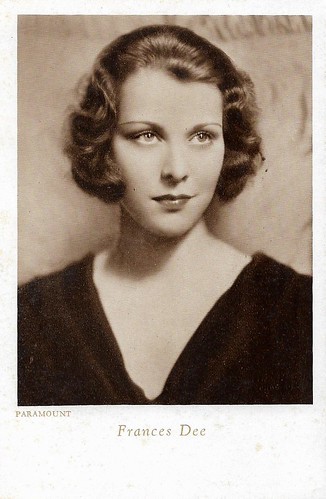
Italian postcard by Cinema-Illustrazione, Milano, series 1, no. 21. Photo: Paramount.
Frances Dee, born in 1907, was living in Los Angeles, and hearing that Fox was making a college picture she suggested that they should use her to get the right college atmosphere. Her work in a minor role in Lubitsch's picture Monte Carlo attracted attention, and she was given the lead opposite Chevalier in Playboy of Paris. Since then she had principal parts in many important pictures, including Little Women, One Man's Journey, Blood Money, and Becky Sharp.
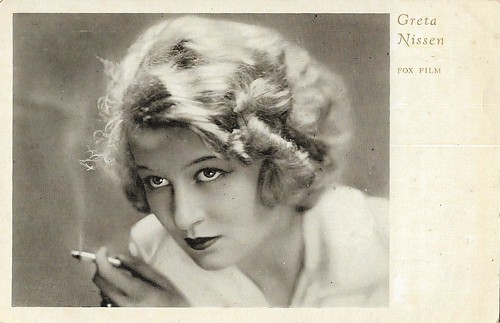
Italian postcard by Cinema-Illustrazione, Milano, series 1, no. 22. Photo: Fox Film.
Blonde Norwegian-American bombshell Greta Nissen (1906-1988) is mostly remembered for a role she didn't play; or, rather, a role that was eventually re-filmed with someone else: the leading lady of Hell's Angels (1930), Howard Hughes’ stunt-flying extravaganza set during World War I.
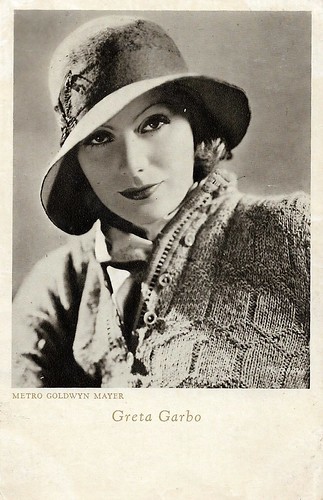
Italian postcard by Cinema-Illustrazione, Milano, series 1, no. 23. Photo: Metro-Goldwyn-Mayer.
Swedish Greta Garbo (1905-1990) was one of the greatest and most glamorous film stars ever produced by the Hollywood studio system. She was part of the Golden Age of the silent cinema of the 1920s and was one of the few actors who made a glorious transition to the talkies. She started her career in European cinema and would always stay more popular in Europe than in the USA.
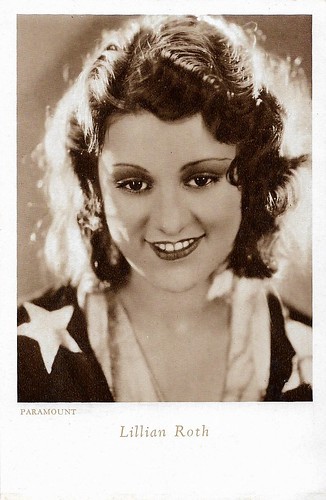
Italian postcard by Cinema-Illustrazione, Milano, series 1, no. 24. Photo: Paramount.
American singer and actress Lillian Roth was a Broadway star and Hollywood actress. Among the films, she made with Paramount were The Love Parade (1929) with Maurice Chevalier, The Vagabond King (1930), Cecil B. DeMille's Madam Satan (1930), and the Marx Brothers second film, Animal Crackers (1930). She rebelled against the pressure of her domineering stage mother and reacted to the death of her fiancé by becoming an alcoholic. Her life story was told in the popular biopic I'll Cry Tomorrow (Daniel Mann, 1955) starring Susan Hayward.
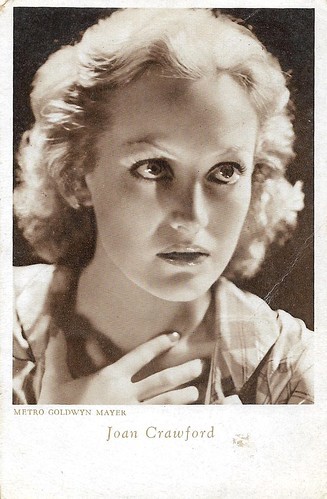
Italian postcard by Cinema-Illustrazione, Milano, series 1, no. 25. Photo: Metro-Goldwyn-Mayer.
American actress Joan Crawford (1905-1977) became nationally-known as a flapper by the end of the 1920s. In the 1930s, her fame rivaled, and later outlasted, MGM colleagues Norma Shearer and Greta Garbo. Crawford often played hardworking young women who find romance and success. These 'rags-to-riches' stories were well received by Depression-era audiences and were popular with women. Crawford became one of Hollywood's most prominent movie stars and one of the highest-paid women in the United States, but her films began losing money and by the end of the 1930s she was labeled 'Box Office Poison'. But her career gradually improved in the early 1940s, and she made a major comeback in 1945 by starring in Mildred Pierce, for which she won the Academy Award for Best Actress.
To be continued next week, Thursday 8 April.
For the editions of the magazine Cinema-Illustrazione between 1930 and 1939, see the website of the Centro Sperimentale.

Italian postcard by Cinema-Illustrazione, Milano, series 1, no. 1. Photo: Paramount.
Mary Brian (1906-2002) was an American actress and film star with dark brown curls and blue/gray eyes, who made the transition from silent films to sound films. She was dubbed 'The Sweetest Girl in Pictures'.

Italian postcard by Cinema-Illustrazione, Milano, Series 1, no. 3. Photo: Paramount.
Beautiful and seductive French actress Lily Damita (1902-1994) appeared in 33 French, Austrian, and Hollywood films between 1922 and 1937. Her marriage with Errol Flynn was rather tempestuous and led to her nickname 'Dynamita'.

Italian postcard by Cinema-Illustrazione, Milano, Series 1, no. 4. Photo: Fox Film.
Yvonne Pelletier (1915-1995) was a Canadian film actress. She was a child actress in the 1920s and had a limited career in 1930s American cinema. This postcard may refer to her pre-Code Fox film Young Sinners (John G. Blystone, 1931) starring Thomas Meighan and Hardie Albright.

Italian postcard by Cinema-Illustrazione, Milano, series 1, no. 6. Photo: Paramount.
Barbara Kent (1907-2011) was an American-Canadian actress of 1920s and 1930s American cinema, known for e.g. Flesh and the Devil (1926), No Man's Law (1927), Lonesome (1928), Feet First (1930), Indiscreet (1931), Emma (1932), and Oliver Twist (1933).

Italian postcard by Cinema-Illustrazione, Milano, Series 1, no. 7. Photo: Fox Film. Myrna Loy in Isle of Escape (Howard Bretherton, 1930).
Myrna Loy (1905-1993) was an American film, television, and stage actress. She was originally typecast in exotic roles, often as a vamp or a woman of Asian descent, but her career prospects improved greatly following her portrayal of Nora Charles in The Thin Man (W.S. Van Dyke, 1934). Suddenly she was 'Queen of the Movies' and remained so until the late 1940s.

Italian postcard by Cinema-Illustrazione, Milano, Series 1, no. 8. Photo: Fox Film.
Petite Janet Gaynor (1906-1984) was the innocent-eyed, round-faced Hollywood star who won the first Academy Award for best actress for her roles in three silent films. She went on to become a leading performer in talking pictures and was one of the most popular Hollywood leading ladies in the 1920s and 1930s. By 1934 she was receiving a yearly salary of $252,583 from Fox, making her Hollywood's most highly paid actress.

Italian postcard by Cinema-Illustrazione, Milano, series 1, no. 9. Photo: Paramount.
Canadian-born American actress Fay Wray (1907-2004) attained international recognition as the first 'scream queen' in a series of horror films during the early 1930s. Through an acting career that spanned nearly six decades, Wray is best known as Ann Darrow, the girl held in the hand of King Kong (1933). Two days after her death, the lights of the Empire State Building, the location of King Kong's climax scene, were dimmed for 15 minutes in memory of the "beauty who charmed the beast".

Italian postcard by Cinema-Illustrazione, Milano, Series 1, no. 10. Photo: Metro-Goldwyn-Mayer.
Lovely Madge Evans (1909-1981) was an American stage and film actress, who often played the 'nice' girl in Hollywood films of the 1930s. She began her career as a child performer and model, starting with Fairy Soap commercials at the age of two.

Italian postcard by Cinema-Illustrazione, Milano, series 1, no. 12. Photo: Metro-Goldwyn-Mayer.
American film actress Dorothy Jordan (1906-1988) emerged at the start of the talkies. She made her film debut as Mary Pickford's sister in Sam Taylor's The Taming of the Shrew (1929). Until 1933 Jordan played the female lead in various films for different studios. These included Min and Bill (1930) with Wallace Beery and Marie Dressler and The Cabin in the Cotton (1932) with Bette Davis. In 1933 Jordan left the film industry to marry film producer and director Merian C. Cooper.

Italian postcard. Cinema-Illustrazione, Milano, Series 1, no. 13. Photo: Metro-Goldwyn-Mayer.
Grace Moore (1898-1947) was an internationally famous star of the Metropolitan Opera and Broadway. During the 1930s, she also starred in several Hollywood musicals. She was nominated for an Oscar for One Night of Love (1934) and was the subject of the biopic So This is Love (1953), in which Kathryn Grayson portrayed the "Tennessee Nightingale", as Grace was called. She died tragically in an airplane crash in 1947 at the height of her career.

Italian postcard by Cinema-Illustrazione, Milano, Series 1, no. 14. Photo: Fox Film.
Sultry, sleepy-eyed Argentine brunette Mona Maris (1903-1991) appeared in both European and Hollywood silent films. After the arrival of sound, she starred in a string of Spanish-language versions of American films.

Italian postcard by Cinema-Illustrazione, Milano, series 1, no. 15. Photo: Metro-Goldwyn-Mayer.
Eleanor Boardman (1898-1991) was an American stage and silent screen actress, famous for King Vidor's The Crowd (1928), one of the best late American silent movies.

Italian postcard by Cinema-Illustrazione, Milano, Series 1, no. 16. Photo: Fox Film. Mona Maris and Humphrey Bogart in A Devil with Women (Irving Cummings, 1930).
Humphrey Bogart (1899-1957) is an icon of Hollywood cinema. His private detectives, Sam Spade in The Maltese Falcon (1941) and Phillip Marlowe in The Big Sleep (1946), became the models for detectives in other Film-Noirs. Bogart and 19-year-old Lauren Bacall fell in love when they filmed To Have and Have Not (1944), the first of a series of films together. He won the best actor Oscar for The African Queen (1951). He was also nominated for Casablanca (1942) and as Captain Queeg in Mutiny on the Caine (1954).

Italian postcard by Cinema-Illustrazione, Milano, series 1, no. 17. Photo: Paramount.
Evelyn Brent (1899-1975) was an American actress of the silent screen. Josef von Sternberg paved the way for her to become a top star through her role of the prostitute Feathers in Underworld (1927).

Italian postcard by Cinema-Illustrazione, Milano, series 1, no. 34. Photo: Fox Film. As Compton was a blonde, we are not sure this really is Joyce Compton.
Joyce Compton (1907-1997) was an American actress. At First National, she landed several leading female roles. In 1926 she was chosen as a potential star among the WAMPAS Baby Stars. With the advent of the talkies in the late 1920s, Compton specialised in supporting roles as dumb blondes with squeaky voices, often paired with her distinctive Southern accent. She maintained this role until the end of her career.

Italian postcard by Cinema-Illustrazione, Milano, series 1, no. 21. Photo: Paramount.
Frances Dee, born in 1907, was living in Los Angeles, and hearing that Fox was making a college picture she suggested that they should use her to get the right college atmosphere. Her work in a minor role in Lubitsch's picture Monte Carlo attracted attention, and she was given the lead opposite Chevalier in Playboy of Paris. Since then she had principal parts in many important pictures, including Little Women, One Man's Journey, Blood Money, and Becky Sharp.

Italian postcard by Cinema-Illustrazione, Milano, series 1, no. 22. Photo: Fox Film.
Blonde Norwegian-American bombshell Greta Nissen (1906-1988) is mostly remembered for a role she didn't play; or, rather, a role that was eventually re-filmed with someone else: the leading lady of Hell's Angels (1930), Howard Hughes’ stunt-flying extravaganza set during World War I.

Italian postcard by Cinema-Illustrazione, Milano, series 1, no. 23. Photo: Metro-Goldwyn-Mayer.
Swedish Greta Garbo (1905-1990) was one of the greatest and most glamorous film stars ever produced by the Hollywood studio system. She was part of the Golden Age of the silent cinema of the 1920s and was one of the few actors who made a glorious transition to the talkies. She started her career in European cinema and would always stay more popular in Europe than in the USA.

Italian postcard by Cinema-Illustrazione, Milano, series 1, no. 24. Photo: Paramount.
American singer and actress Lillian Roth was a Broadway star and Hollywood actress. Among the films, she made with Paramount were The Love Parade (1929) with Maurice Chevalier, The Vagabond King (1930), Cecil B. DeMille's Madam Satan (1930), and the Marx Brothers second film, Animal Crackers (1930). She rebelled against the pressure of her domineering stage mother and reacted to the death of her fiancé by becoming an alcoholic. Her life story was told in the popular biopic I'll Cry Tomorrow (Daniel Mann, 1955) starring Susan Hayward.

Italian postcard by Cinema-Illustrazione, Milano, series 1, no. 25. Photo: Metro-Goldwyn-Mayer.
American actress Joan Crawford (1905-1977) became nationally-known as a flapper by the end of the 1920s. In the 1930s, her fame rivaled, and later outlasted, MGM colleagues Norma Shearer and Greta Garbo. Crawford often played hardworking young women who find romance and success. These 'rags-to-riches' stories were well received by Depression-era audiences and were popular with women. Crawford became one of Hollywood's most prominent movie stars and one of the highest-paid women in the United States, but her films began losing money and by the end of the 1930s she was labeled 'Box Office Poison'. But her career gradually improved in the early 1940s, and she made a major comeback in 1945 by starring in Mildred Pierce, for which she won the Academy Award for Best Actress.
To be continued next week, Thursday 8 April.
For the editions of the magazine Cinema-Illustrazione between 1930 and 1939, see the website of the Centro Sperimentale.
Published on March 31, 2021 22:00
March 30, 2021
Nat King Cole
American singer and pianist Nat 'King' Cole (1919-1965) with his typical raspy voice received 28 golden records for such classic hits as 'Mona Lisa' (1949), 'Too Young' (the #1 song in 1951), his signature tune 'Unforgettable' (1951) and 'Ramblin' Rose' (1962). He also appeared in several films, including St. Louis Blues (1958) and Cat Ballou (1965).

Dutch postcard by Takken, no. AX 2002.
(Get Your Kicks on) Route 66
Nat 'King' Cole was born Nathaniel Adams Coles in Montgomery, Alabama, in 1919. When he was four or five (the sources differ), his family moved to Chicago. There his father, Edward James Coles, was a minister at the True Light Baptist Church and later Pastor of the First Baptist Church.
Nat received music lessons from his mother. He learned jazz and gospel music, but also Western classical music. At 12 he was playing the church organ and at 14, he formed a 14 piece band called the Royal Dukes.
His three brothers, Ike Cole, Eddie Cole, and Frankie Cole also played the piano and later sang professionally. In 1939 Nat formed the King Cole Trio after his publicist put a silver tin-foiled crown on his head and proclaimed him King.
He became known as a leading jazz pianist. He soon also became noted for his soft, baritone voice. His recordings of 'Straighten Up And Fly Right' (1943), which sold over 500,000 copies, and '(Get Your Kicks on) Route 66' (1946) would become classics and influenced several Rock and roll singers of the 1950s.
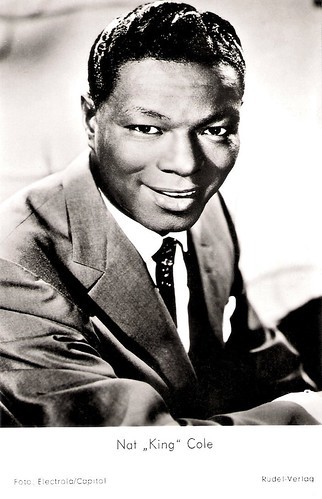
German postcard by Rüdel-Verlag, Hamburg-Bergedorf, no. 3119. Photo: Electrola / Capitol.
Attacked by the White Citizens Council
Nat 'King' Cole met his second wife Maria (a big-band singer) at the Zanzibar nightclub in Los Angeles through the Eddie 'Rochester' Anderson show. Her parents protested her decision to marry Cole, claiming he was "too black".
However, they were married in 1948 and would have five children, including singer Natalie Cole. When he and his family moved to the upscale Hancock Park area of Los Angeles in the late 1940s, they were met with considerable opposition from the residents of the previously all-white neighborhood.
When the neighbors finally realised - after several attempts, including legal action - that the Coles were not going to be intimidated, they accepted defeat and, ultimately, the Coles as well.
In the mid-1950s, Nat had several mainstream Rock and Roll hits including 'Send For Me', 'With You On My Mind', 'When Rock and Roll Come To Trinidad', and 'Looking Back'.
He often toured Europe and made a command performance before Queen Elizabeth II. He was the first African-American to have his own TV show - the highly-rated The Nat King Cole Show (1954). Cole canceled the show because no company was willing to sponsor the show.
In 1956, Cole was attacked during a concert in Birmingham, Alabama, by six white men from a white supremacist group called the White Citizens Council. He sustained minor injuries to his back.
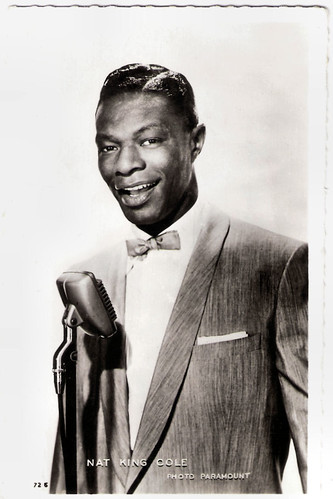
French postcard by Editions P.I., Paris, no. 726. Photo: Paramount, 1956.
Breakfast in Hollywood
Nat 'King' Cole appeared in several films. Uncredited, he made his film debut in Citizen Kane (Orson Welles, 1941) as a pianist in El Rancho. He performed songs in musicals like Here Comes Elmer (Joseph Santley, 1943), Pin-Up Girl (H. Bruce Humberstone, 1944) starring Betty Grable , and Breakfast in Hollywood (Harold D. Schuster, 1946).
During the 1950s, both the films and his part became bigger, such as in Fritz Lang 's Film Noir The Blue Gardenia (1953), Kiss Me Deadly (Robert Aldrich, 1955), and the war drama China Gate (Samuel Fuller, 1957) with Angie Dickinson .
He played the lead role in St. Louis Blues (Allen Reisner, 1958), a biopic of turn-of-the-century blues composer W. C. Handy. Cole also worked in the European cinema and appeared in the Schlager film Schlager-Raketen/Schlager missiles (Erik Ode, 1960). His last film was the comic Western Cat Ballou (Elliot Silverstein, 1965), starring Lee Marvin and Jane Fonda .
He was also a composer and his song 'Straighten Up and Fly Right' was sold for $50.00. A heavy smoker, he died of lung cancer in 1965 in Santa Monica, California, USA. He was only 45.
In 1991, his song 'Unforgettable' was made famous again by Cole's daughter Natalie when modern recording technology was used to reunite father and daughter in a duet. The duet version rose to the top of the pop charts, almost forty years after its original popularity.
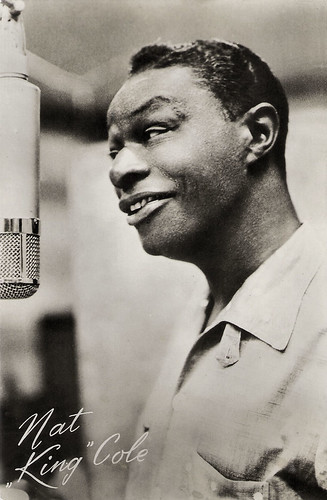
Dutch postcard by Uitg. Takken, Utrecht, no. 3559.
Source: (IMDb), Wikipedia, and .

Dutch postcard by Takken, no. AX 2002.
(Get Your Kicks on) Route 66
Nat 'King' Cole was born Nathaniel Adams Coles in Montgomery, Alabama, in 1919. When he was four or five (the sources differ), his family moved to Chicago. There his father, Edward James Coles, was a minister at the True Light Baptist Church and later Pastor of the First Baptist Church.
Nat received music lessons from his mother. He learned jazz and gospel music, but also Western classical music. At 12 he was playing the church organ and at 14, he formed a 14 piece band called the Royal Dukes.
His three brothers, Ike Cole, Eddie Cole, and Frankie Cole also played the piano and later sang professionally. In 1939 Nat formed the King Cole Trio after his publicist put a silver tin-foiled crown on his head and proclaimed him King.
He became known as a leading jazz pianist. He soon also became noted for his soft, baritone voice. His recordings of 'Straighten Up And Fly Right' (1943), which sold over 500,000 copies, and '(Get Your Kicks on) Route 66' (1946) would become classics and influenced several Rock and roll singers of the 1950s.

German postcard by Rüdel-Verlag, Hamburg-Bergedorf, no. 3119. Photo: Electrola / Capitol.
Attacked by the White Citizens Council
Nat 'King' Cole met his second wife Maria (a big-band singer) at the Zanzibar nightclub in Los Angeles through the Eddie 'Rochester' Anderson show. Her parents protested her decision to marry Cole, claiming he was "too black".
However, they were married in 1948 and would have five children, including singer Natalie Cole. When he and his family moved to the upscale Hancock Park area of Los Angeles in the late 1940s, they were met with considerable opposition from the residents of the previously all-white neighborhood.
When the neighbors finally realised - after several attempts, including legal action - that the Coles were not going to be intimidated, they accepted defeat and, ultimately, the Coles as well.
In the mid-1950s, Nat had several mainstream Rock and Roll hits including 'Send For Me', 'With You On My Mind', 'When Rock and Roll Come To Trinidad', and 'Looking Back'.
He often toured Europe and made a command performance before Queen Elizabeth II. He was the first African-American to have his own TV show - the highly-rated The Nat King Cole Show (1954). Cole canceled the show because no company was willing to sponsor the show.
In 1956, Cole was attacked during a concert in Birmingham, Alabama, by six white men from a white supremacist group called the White Citizens Council. He sustained minor injuries to his back.

French postcard by Editions P.I., Paris, no. 726. Photo: Paramount, 1956.
Breakfast in Hollywood
Nat 'King' Cole appeared in several films. Uncredited, he made his film debut in Citizen Kane (Orson Welles, 1941) as a pianist in El Rancho. He performed songs in musicals like Here Comes Elmer (Joseph Santley, 1943), Pin-Up Girl (H. Bruce Humberstone, 1944) starring Betty Grable , and Breakfast in Hollywood (Harold D. Schuster, 1946).
During the 1950s, both the films and his part became bigger, such as in Fritz Lang 's Film Noir The Blue Gardenia (1953), Kiss Me Deadly (Robert Aldrich, 1955), and the war drama China Gate (Samuel Fuller, 1957) with Angie Dickinson .
He played the lead role in St. Louis Blues (Allen Reisner, 1958), a biopic of turn-of-the-century blues composer W. C. Handy. Cole also worked in the European cinema and appeared in the Schlager film Schlager-Raketen/Schlager missiles (Erik Ode, 1960). His last film was the comic Western Cat Ballou (Elliot Silverstein, 1965), starring Lee Marvin and Jane Fonda .
He was also a composer and his song 'Straighten Up and Fly Right' was sold for $50.00. A heavy smoker, he died of lung cancer in 1965 in Santa Monica, California, USA. He was only 45.
In 1991, his song 'Unforgettable' was made famous again by Cole's daughter Natalie when modern recording technology was used to reunite father and daughter in a duet. The duet version rose to the top of the pop charts, almost forty years after its original popularity.

Dutch postcard by Uitg. Takken, Utrecht, no. 3559.
Source: (IMDb), Wikipedia, and .
Published on March 30, 2021 22:00
March 29, 2021
Olga and Carlo Benetti
Italian actress Olga Benetti (?-1958) acted in many films of the Roman film companies Cines, Celio, and Caesar in the 1910s and early 1920s. She often performed opposite Francesca Bertini, Gustavo Serena, and her husband Carlo Benetti (1885-1949).
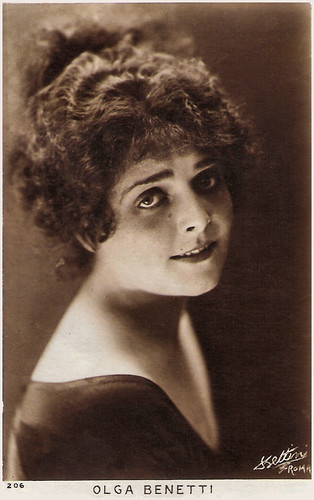
Olga Benetti. Italian postcard by Ed. Soc. Anon. It. Bettini, Roma, no. 206.
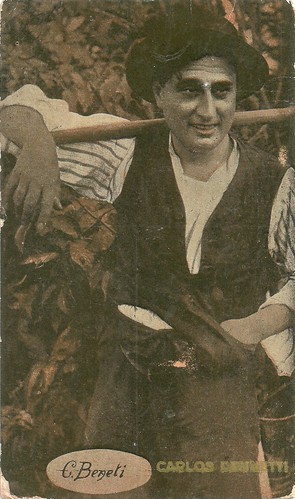
Carlo Benetti. Spanish collectors card by Amatller Marca Luna, Series no. 1. Photo: Principales Artistas Cinematograficos. On the front of the card, Benetti is misspelled as 'C. Beneti' and at the back of the card, the actor's name is spelled as 'Carlos Bennetti' (sic).
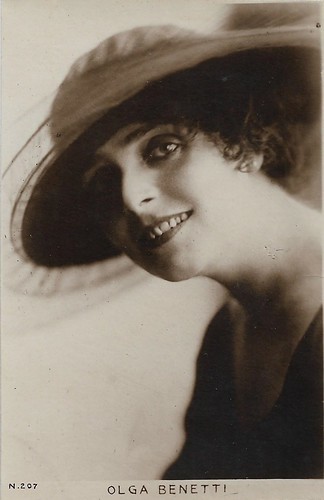
Italian postcard, no. 207. Photo: Bettini.
They immediately got the leads in six films
Carlo Benetti was born in Florence in 1885. Olga Benetti was born on an unknown date in Ceprano (Frosinone). They were married before they entered the film business.
Both debuted in 1912 at the Cines company with two short comedies, E' meglio l'arte/Because of a Widow (N.N., 1912) and In campagna è un'altra cosa/Their Country Relations (N.N., 1912).
In 1913, they were hired by the Latium film company. They immediately got the leads in six films: La finestra illuminata/The Light in the Window (1913), Passa una donna!/Stella Lescaut (1913), La mano della scimmia/The Strange Theft (1913), Verso l'amore/Towards love (1913), and L'orrida meta/The horrid goal (1913). All were directed by Ubaldo Pittei.
The engagement with Latium didn't last long, though. In September 1913 they started to work for the joint companies Cines and Celio. Together they were the protagonists in the drama Un divorzio/A divorce (1914). They also worked as supporting actors.
Olga played opposite Leda Gys and Alberto Collo in the Cines drama Amore bendato/Love Is Blind (1914), and both in Il club delle maschere/The Ghost Club (Mario Ghione, 1913), starring Mario Bonnard .
Other titles were e.g. L'oro maledetto/The Lure of Gold (Ivo Illuminati, 1914) for Celio and La parola che uccide/The word that kills (Augusto Genina, 1914) for Cines.
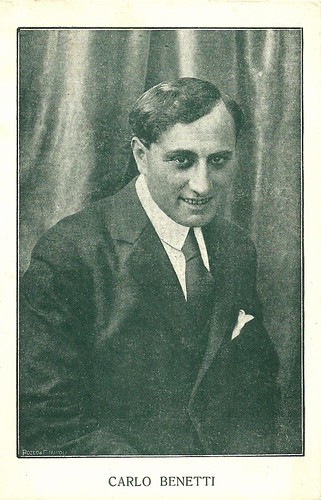
Italian postcard by Magazine Film - corriere dei cinematografici, Napoli/Roma. Photo: Poseo & Co., Napoli.
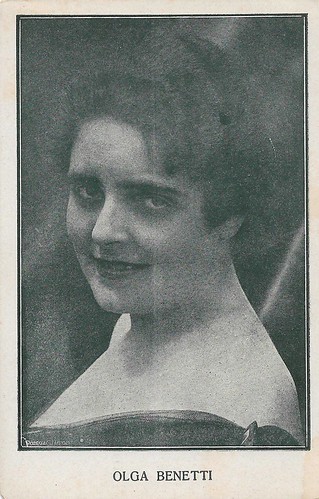
Italian postcard by Magazine Film - corriere dei cinematografici, Napoli/Roma. Photo: Poseo & Co., Napoli / Caesar Film.
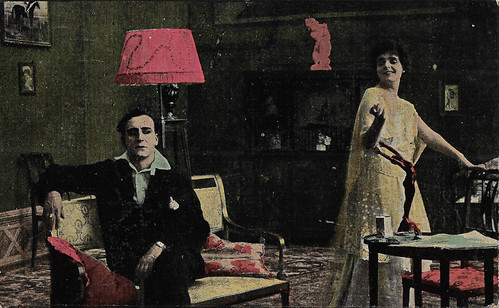
Spanish collectors card by Chocolat Imperiale, no. 10. Photo: Pinto, Roma / Caesar Film. Guido Trento and Olga Benetti in Frou-Frou (Alfredo De Antoni, 1918), adapted from the play by Meilhac and Halevy.
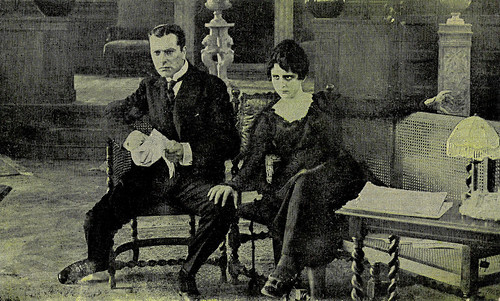
Spanish postcard by Amattler Marca Luna chocolate, series 7, no. 13. Livio Pavanelli and Olga Benetti have just heard they will probably not inherit the throne in Carnevalesca (Amleto Palermi 1918), after Lucio d'Ambra. Photography was by Giovanni Grimaldi.
The bond with Francesca Bertini
At the end of 1914, the Benetti couple moved to the Caesar company, where Olga had leads in films by Emilio Ghione such as L'ultimo dovere/The ultimate duty (Emilio Ghione, 1915), and Per la sua pace/For his peace (Emilio Ghione, 1915).
However, equally important were Olga Benetti's roles as an antagonist in the Francesca Bertini dramas, starting with Benetti's first feature-length film, Nelly la Gigolette/Nelly the gigolette (Emilio Ghione, 1915). The bond would last for years, with memorable such titles as La signora delle camelie (Gustavo Serena, 1915), Odette (Giuseppe de Liguoro, 1916), Fedora (Giuseppe de Liguoro, Gustavo Serena, 1916), Andreina (Gustavo Serena, 1917), La piccola fonte/The small source (Roberto Roberti, 1917), and Tosca (Alfredo De Antoni, 1918).
In 1918, she also played Clorinda opposite Amleto Novelli and Edy Darclea in the historical epic La Gerusalemme liberata/Jerusalem Liberated (Enrico Guazzoni, 1918), based on an epic poem by Torquato Tasso from 1581.
Carlo often co-acted in these films too, such as in Nelly la Gigolette and Odette. In 1915 Carlo played without his wife as Don Federigo opposite Francesca Bertini in the latter's classical 'verist' drama Assunta Spina (Francesca Bertini, Gustavo Serena, 1915). Without Olga, he also played with Bertini in Il capestro degli Asburgo/The halter of the Habsburgs (Gustavo Serena, 1915), Ivonne, la bella danzatrice/Ivonne, the beautiful dancer (Gustavo Serena, 1915), Diana, l'affascinatrice/Diana the Seductress (Gustavo Serena, 1915), La perla del cinema/The pearl of cinema (Giuseppe de Liguoro, 1916), and Lacrymae rerum/Tears (Giuseppe de Liguoro, 1916).
In the mid-1910s the Benetti's were highly productive regulars of the Caesar troupe and thus also appeared in several films by Gustavo Serena , Emilio Ghione , Camillo De Riso , and Edoardo Bencivenga - often performing in the leads or as most important antagonists.
By 1918 the golden years at Caesar were over. The couple moved to Filmograf, where they acted in films by Gian Orlando Vassallo and Gustavo Serena . Between 1920 and 1924 the couple acted in films at Rinascimento Film and FERT in Turin and at Libertas in Rome. Carlo played in several films with Maria Jacobini and directed by Gennaro Righelli: La casa di vetro/The glass house (1920), Il richiamo/The recall (1921), Il viaggio/The Trip (1921), and Cainà/Cainà: The Island and the Continent (1922). He also played opposite Jacobini in Guglielmo Zorzi's La bocca chiusa/The closed mouth (1924).
He also acted with Italia Almirante Manzini in La grande passion/The great passione (Mario Almirante, 1922), with Helena Makowska in La dama e il mistero/The Lady and the Mystery (Amleto Palermi, 1921), and with Rina De Liguoro in Maremma (Salvatore Aversano, 1924).
La vergine del faro/The virgin of the lighthouse (Telemaco Ruggeri, 1924) was Olga's last film. In the later 1920s Carlo could still be seen in such films as Fra Diavolo (Mario Gargiulo, Roberto Roberti, 1925), Kiff Tebby (Mario Camerini, 1928), and La locandiera/The innkeeper (Telemaco Ruggeri, 1929).
Carlo Benetti died in 1949 in Rome, Lazio, Italy. His wife had passed away a year earlier, in 1948.
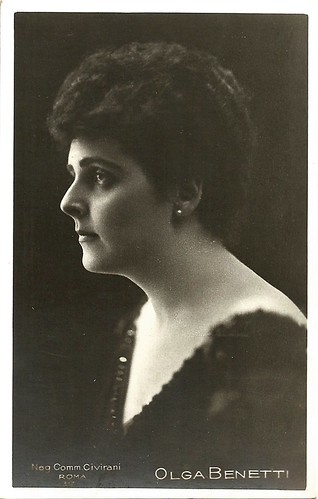
Italian postcard. Photo Civirani, Rome.
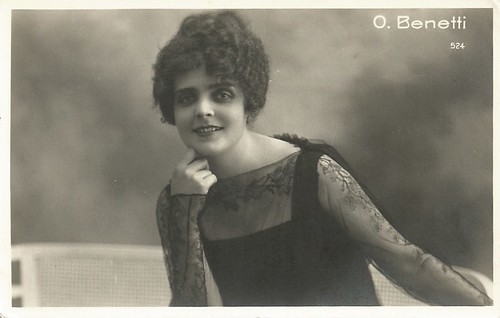
Italian postcard by Ed. Vettori, Bologna, no. 524.
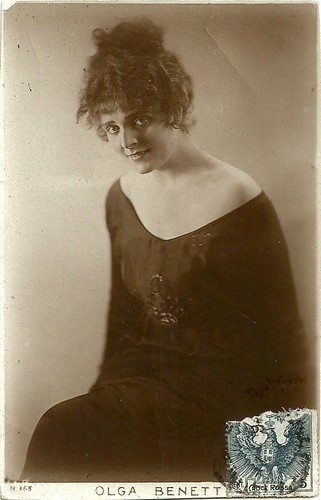
Italian postcard by Ed. Soc. Anon. It. Bettini, Roma, no. 165.
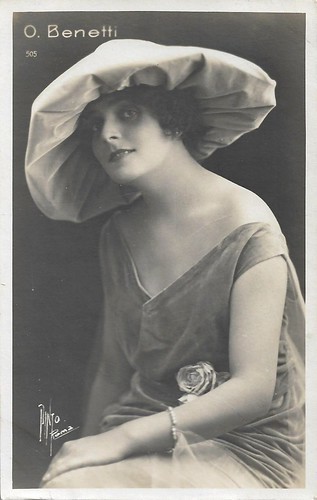
Italian postcard by Ed. G. Vettori, Bologna, no. 505. Photo: Pinto, Roma.
Sources: Aldo Bernardini (Cinema muto italiano. Protagonisti - Italian), Aldo Bernardini/Vittorio Martinelli (Il cinema muto italiano, 1912-1929), and .
NB. IMDb erroneously claims Olga was also in the 1911 version of Gerusalemme liberata/The Crusaders (Enrico Guazzoni, 1911). Prints of Verso l’amore, Amore bendato, and a fragment of Fedora can be found in the collection of the Eye Filmmuseum in Amsterdam.

Olga Benetti. Italian postcard by Ed. Soc. Anon. It. Bettini, Roma, no. 206.

Carlo Benetti. Spanish collectors card by Amatller Marca Luna, Series no. 1. Photo: Principales Artistas Cinematograficos. On the front of the card, Benetti is misspelled as 'C. Beneti' and at the back of the card, the actor's name is spelled as 'Carlos Bennetti' (sic).

Italian postcard, no. 207. Photo: Bettini.
They immediately got the leads in six films
Carlo Benetti was born in Florence in 1885. Olga Benetti was born on an unknown date in Ceprano (Frosinone). They were married before they entered the film business.
Both debuted in 1912 at the Cines company with two short comedies, E' meglio l'arte/Because of a Widow (N.N., 1912) and In campagna è un'altra cosa/Their Country Relations (N.N., 1912).
In 1913, they were hired by the Latium film company. They immediately got the leads in six films: La finestra illuminata/The Light in the Window (1913), Passa una donna!/Stella Lescaut (1913), La mano della scimmia/The Strange Theft (1913), Verso l'amore/Towards love (1913), and L'orrida meta/The horrid goal (1913). All were directed by Ubaldo Pittei.
The engagement with Latium didn't last long, though. In September 1913 they started to work for the joint companies Cines and Celio. Together they were the protagonists in the drama Un divorzio/A divorce (1914). They also worked as supporting actors.
Olga played opposite Leda Gys and Alberto Collo in the Cines drama Amore bendato/Love Is Blind (1914), and both in Il club delle maschere/The Ghost Club (Mario Ghione, 1913), starring Mario Bonnard .
Other titles were e.g. L'oro maledetto/The Lure of Gold (Ivo Illuminati, 1914) for Celio and La parola che uccide/The word that kills (Augusto Genina, 1914) for Cines.

Italian postcard by Magazine Film - corriere dei cinematografici, Napoli/Roma. Photo: Poseo & Co., Napoli.

Italian postcard by Magazine Film - corriere dei cinematografici, Napoli/Roma. Photo: Poseo & Co., Napoli / Caesar Film.

Spanish collectors card by Chocolat Imperiale, no. 10. Photo: Pinto, Roma / Caesar Film. Guido Trento and Olga Benetti in Frou-Frou (Alfredo De Antoni, 1918), adapted from the play by Meilhac and Halevy.

Spanish postcard by Amattler Marca Luna chocolate, series 7, no. 13. Livio Pavanelli and Olga Benetti have just heard they will probably not inherit the throne in Carnevalesca (Amleto Palermi 1918), after Lucio d'Ambra. Photography was by Giovanni Grimaldi.
The bond with Francesca Bertini
At the end of 1914, the Benetti couple moved to the Caesar company, where Olga had leads in films by Emilio Ghione such as L'ultimo dovere/The ultimate duty (Emilio Ghione, 1915), and Per la sua pace/For his peace (Emilio Ghione, 1915).
However, equally important were Olga Benetti's roles as an antagonist in the Francesca Bertini dramas, starting with Benetti's first feature-length film, Nelly la Gigolette/Nelly the gigolette (Emilio Ghione, 1915). The bond would last for years, with memorable such titles as La signora delle camelie (Gustavo Serena, 1915), Odette (Giuseppe de Liguoro, 1916), Fedora (Giuseppe de Liguoro, Gustavo Serena, 1916), Andreina (Gustavo Serena, 1917), La piccola fonte/The small source (Roberto Roberti, 1917), and Tosca (Alfredo De Antoni, 1918).
In 1918, she also played Clorinda opposite Amleto Novelli and Edy Darclea in the historical epic La Gerusalemme liberata/Jerusalem Liberated (Enrico Guazzoni, 1918), based on an epic poem by Torquato Tasso from 1581.
Carlo often co-acted in these films too, such as in Nelly la Gigolette and Odette. In 1915 Carlo played without his wife as Don Federigo opposite Francesca Bertini in the latter's classical 'verist' drama Assunta Spina (Francesca Bertini, Gustavo Serena, 1915). Without Olga, he also played with Bertini in Il capestro degli Asburgo/The halter of the Habsburgs (Gustavo Serena, 1915), Ivonne, la bella danzatrice/Ivonne, the beautiful dancer (Gustavo Serena, 1915), Diana, l'affascinatrice/Diana the Seductress (Gustavo Serena, 1915), La perla del cinema/The pearl of cinema (Giuseppe de Liguoro, 1916), and Lacrymae rerum/Tears (Giuseppe de Liguoro, 1916).
In the mid-1910s the Benetti's were highly productive regulars of the Caesar troupe and thus also appeared in several films by Gustavo Serena , Emilio Ghione , Camillo De Riso , and Edoardo Bencivenga - often performing in the leads or as most important antagonists.
By 1918 the golden years at Caesar were over. The couple moved to Filmograf, where they acted in films by Gian Orlando Vassallo and Gustavo Serena . Between 1920 and 1924 the couple acted in films at Rinascimento Film and FERT in Turin and at Libertas in Rome. Carlo played in several films with Maria Jacobini and directed by Gennaro Righelli: La casa di vetro/The glass house (1920), Il richiamo/The recall (1921), Il viaggio/The Trip (1921), and Cainà/Cainà: The Island and the Continent (1922). He also played opposite Jacobini in Guglielmo Zorzi's La bocca chiusa/The closed mouth (1924).
He also acted with Italia Almirante Manzini in La grande passion/The great passione (Mario Almirante, 1922), with Helena Makowska in La dama e il mistero/The Lady and the Mystery (Amleto Palermi, 1921), and with Rina De Liguoro in Maremma (Salvatore Aversano, 1924).
La vergine del faro/The virgin of the lighthouse (Telemaco Ruggeri, 1924) was Olga's last film. In the later 1920s Carlo could still be seen in such films as Fra Diavolo (Mario Gargiulo, Roberto Roberti, 1925), Kiff Tebby (Mario Camerini, 1928), and La locandiera/The innkeeper (Telemaco Ruggeri, 1929).
Carlo Benetti died in 1949 in Rome, Lazio, Italy. His wife had passed away a year earlier, in 1948.

Italian postcard. Photo Civirani, Rome.

Italian postcard by Ed. Vettori, Bologna, no. 524.

Italian postcard by Ed. Soc. Anon. It. Bettini, Roma, no. 165.

Italian postcard by Ed. G. Vettori, Bologna, no. 505. Photo: Pinto, Roma.
Sources: Aldo Bernardini (Cinema muto italiano. Protagonisti - Italian), Aldo Bernardini/Vittorio Martinelli (Il cinema muto italiano, 1912-1929), and .
NB. IMDb erroneously claims Olga was also in the 1911 version of Gerusalemme liberata/The Crusaders (Enrico Guazzoni, 1911). Prints of Verso l’amore, Amore bendato, and a fragment of Fedora can be found in the collection of the Eye Filmmuseum in Amsterdam.
Published on March 29, 2021 22:00
March 28, 2021
Madonna
Madonna or Madonna Louise Ciccone (1958) is an American singer, songwriter, and actress. During the MTV craze in the 1980s, Madonna pushed boundaries with her provocative song texts and performances. She frequently reinvented herself and her music and Madonna stayed the 'Queen of Pop' for decades. Her global bestsellers were hits such as Like a Virgin (1984) and True Blue (1986), but for us, she became more interesting with songs like Like a Prayer (1989), Vogue (1991), and Frozen (1998). And we're still fans, even of some of her films, including Desperately Seeking Susan (1985), Truth or Dare (1991), and Evita (1996).
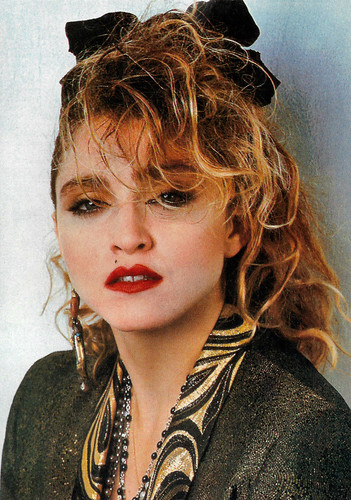
French postcard in the 'série chanteurs' by Editions Gil/Edition F. Nugeron, no. 131. Madonna in Desperately Seeking Susan (Susan Seidelman, 1985).
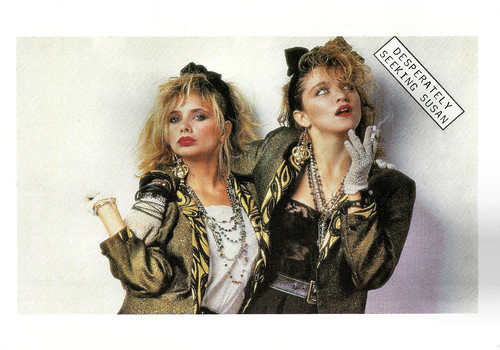
British postcard, no. FA 213. Rosanna Arquette and Madonna in Desperately Seeking Susan (Susan Seidelman, 1985).

French postcard by Editions Humour à la Carte, Paris, no. A-C 1217. Photo: UGC Distribution. Madonna and Sean Penn in Shanghai Surprise (Jim Goddard, 1986).
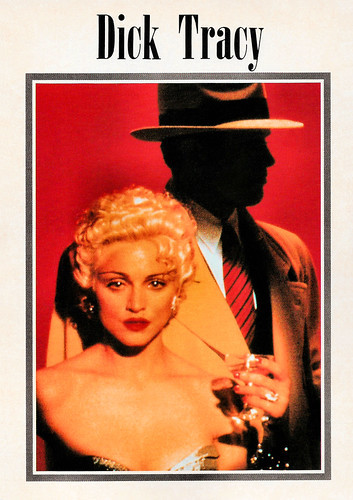
British postcard New-Line, no. 229. Photo: Madonna and Warren Beatty in Dick Tracy (Warren Beatty, 1990).
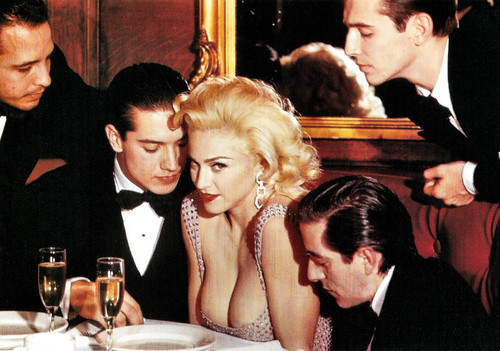
Vintage postcard, no. AB 79. Photo: Steven Meisel. Publicity still for Madonna: Truth or Dare/In Bed with Madonna (Alek Keshishian, 1991). Madonna impersonating Jayne Mansfield .
Rosaries and crosses as jewelry and black rubber typewriter bands as bracelets
Madonna was born Madonna Louise Ciccone in 1958 in Bay City, Michigan. Her father is Italian, her mother was French-Canadian. Her siblings are Anthony Ciccone (1956), Martin Ciccone (1957), Paula Ciccone (1959), Christopher Ciccone (1960), and Melanie Henry (1962).
In 1962, Madonna's mother, pregnant with her sixth child, was diagnosed with breast cancer. She delayed treatment until her baby was born, but by that time it was too late. A harrowing, yearlong battle with the disease ensued. She lost her battle with cancer in 1963.
In 1978, Madonna moved to New York and studied with renowned choreographer Alvin Ailey. She joined up with the Patrick Hernandez Revue, formed a pop/dance band called 'Breakfast Club', and began working with then-boyfriend Stephen Bray on recording several disco-oriented songs. New York producer/D.J. Mark Kamins passed her demo tapes to Sire Records in early 1982 and the rest is history.
The 1980s was Madonna's boom decade, and she dominated the music charts with a succession of multimillion-selling albums. Madonna first appeared on screen in two low-budget films marketed to an adolescent audience: A Certain Sacrifice (Stephen Jon Lewicki, 1979) and Crazy for You (Harold Becker, 1985), starring Matthew Modine. Her first film, A Certain Sacrifice (1979), was released in 1985, after she became a star, but was actually shot in two parts, the first in 1979, and the other, in 1981.
However, she scored a minor cult hit with Desperately Seeking Susan (Susan Seidelman, 1985) starring alongside spunky Rosanna Arquette. In 1984, she started fashion trends with her unique look using rosaries and crosses as jewelry and black rubber typewriter bands as bracelets. Legions of adolescent girls mimicked her look and a Madonna clothing store was opened in New York. Again in 2001, another huge fashion trend was set off by the "Material Mom", this time with Western wear - cowboy hats and mud-splattered jeans.
In 1986, she starred with then-husband Sean Penn in Shanghai Surprise (Jim Goddard, 1986), which was savaged by critics. She managed to somewhat improve her standing in the cinema with her next two films, the off-beat Who's That Girl (James Foley, 1987) and the quirky Damon Runyon-inspired Bloodhounds of Broadway (Howard Brookner, 1989).
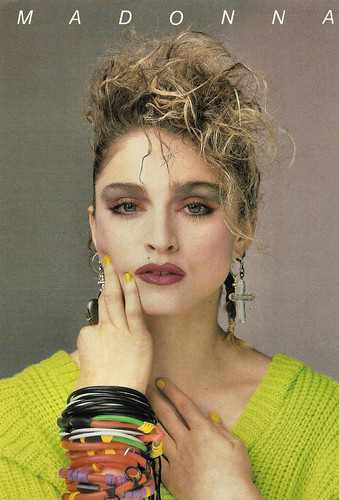
Dutch promotion card by Verenigde Spaarbank, Utrecht.
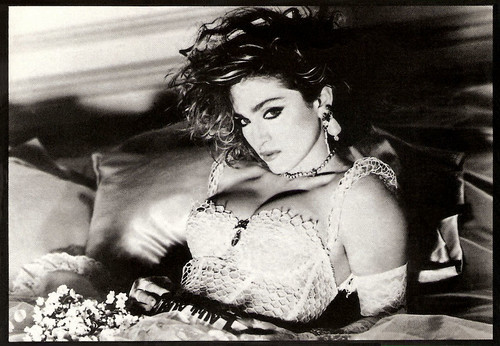
British postcard by Santoro Graphics, London, no. BW123. Photo: Steven Meisel. Photo for the cover of the album 'Like a Virgin' (1984).
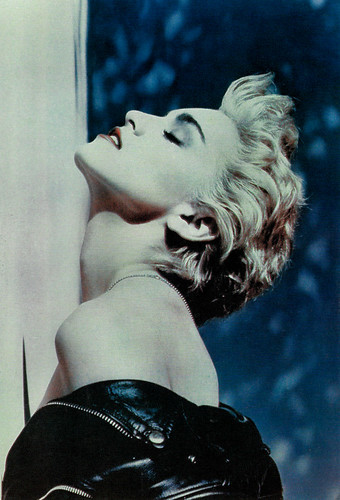
American postcard Classico, San Francisco / Winterland Productions / Rock Express, no. 460-053. Photo: Herb Ritts / Boy Toy Inc., 1991. Photo for the cover of the album 'True Blue' (1986).
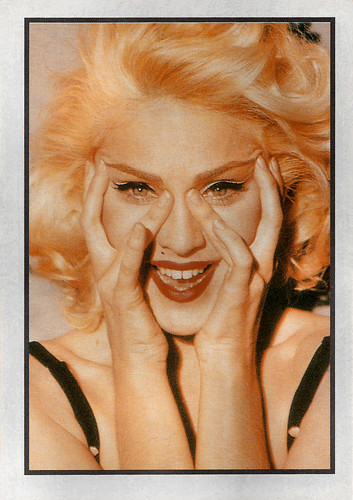
Vintage postcard, no. DK 647. Photo: Steven Meisel.
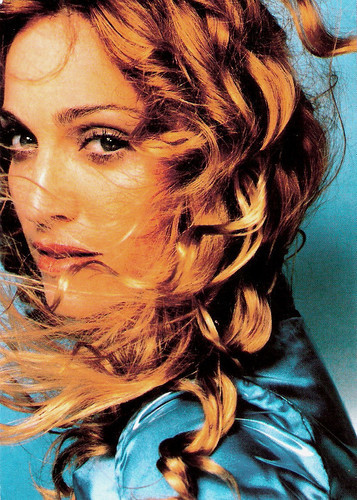
German postcard by Warner Music Germany. Photo: Mario Testino. Publicity still for the album Ray of Light (1998).
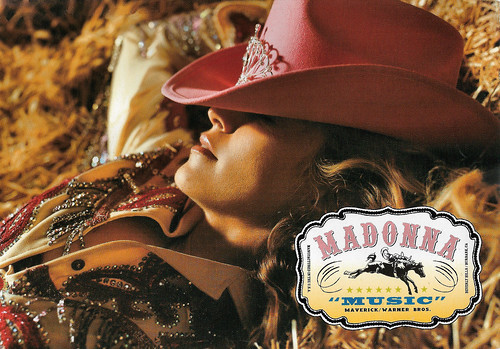
French promotion card. Photo: J. B. Mondino / WEA. The postcard promotes Madonna's album and single 'Music'. The album premiered in France on 18 September 2000 and the single on 22 August 2000.
A Golden Globe for Best Actress
Madonna played in the big-budget and star-filled Dick Tracy (Warren Beatty, 1990) bad girl Breathless Mahoney flirting with Warren Beatty. The epic failed to catch fire at the box office. However, her next film, the tell-all documentary Madonna: Truth or Dare (Alek Keshishian, 1991) which followed on her controversial Blond Ambition tour in 1990, fared much better at the box office. Filmed in black and white, with the concert pieces in colour, it is an intimate look at the work of the music performer, from a prayer circle with the dancers before each performance to bed games with the dance troupe afterwards.
Madonna got good reviews as a feisty baseball player alongside Tom Hanks and Geena Davis in the entertaining A League of Their Own (Penny Marshall, 1992), a story about female baseball players during W.W.II.
Madonna drew the wrath of critics with the whodunnit Body of Evidence (Uli Edel, 1992) with Willem Dafoe, an obvious attempt to cash in on the success of the sexy Sharon Stone thriller Basic Instinct (Paul Verhoeven, 1992). For this pseudo-S&M thriller, her show-and-tell photo book 'Sex', and her subpar dance album 'Erotica' she received a maelstrom of negative publicity.
Several minor screen roles followed, but then Madonna starred as Eva Perón opposite Jonathan Pryce and Antonio Banderas in Evita (Alan Parker, 1996). She received a Golden Globe for Best Actress for her role in this fairly well-received screen adaptation of the hugely successful Broadway musical.
Madonna stayed away from the film cameras for several years. She returned to the screen co-starring with Rupert Everett in the romantic comedy The Next Best Thing (John Schlesinger, 2000), followed by the painfully bad Swept Away (2002) for husband Guy Ritchie. She was again miscast as a vampish fencing instructor in the James Bond adventure Die Another Day (Lee Tamahori, 2002) starring Pierce Brosnan .
In 2008, Madonna began a directing career with the comedy Filth and Wisdom (Madonna, 2008), and a year later she reunited with director Alek Keshishian to develop a script about the relationship between the Duke of Windsor and the Duchess of Windsor that led to his abdication in 1936. The result was the film W.E. (Madonna, 2011), starring James D'Arcy and Andrea Riseborough as the infernal but still royal couple. The film was released in 2011 to lukewarm critics but it gathered one Oscar nomination for costumes. Madonna contributed the ballad 'Masterpiece' for the film's soundtrack, which won her a Golden Globe Award for Best Original Song.
In the following years, Madonna continued to perform and record albums, but her film career seemed over. However, in 2020, Madonna posted a video on her Instagram where she discussed ideas for a script with writer Diablo Cody. Later she confirmed on an Instagram live stream they were writing a film about her life, to be produced by Amy Pascal.
Wikipedia : "With sales of over 300 million records worldwide, Madonna is certified as the best-selling female recording artist of all time by Guinness World Records. She is the most successful solo artist in the history of the US Billboard Hot 100 chart and holds the record for the most number-one singles by a female artist in Australia, Canada, Italy, Spain, and the United Kingdom. With a revenue of U.S. $1.5 billion from her concert tickets, she remains the highest-grossing solo touring artist of all time."
Madonna has 6 children: daughter Lourdes Leon (1996) with ex-boyfriend Carlos Leon, son Rocco Ritchie (2000), and adoptive son, David Banda Mwale Ciccone Ritchie (2005) with ex-husband Guy Ritchie, and three adoptive daughters, Mercy James Ciccone (2006), and the twins Estere Ciccone and Stella Ciccone (2012).

French postcard by Editions Humour à la Carte, Paris, no. ST-56.
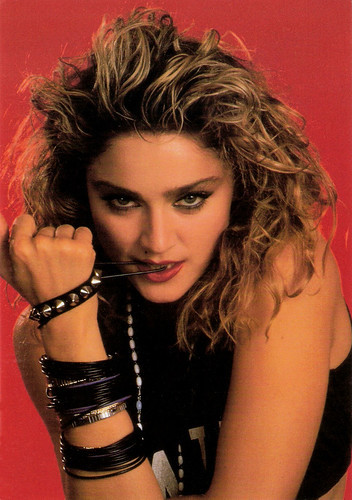
English postcard by Anabas, Romford, no. AP182, 1986.
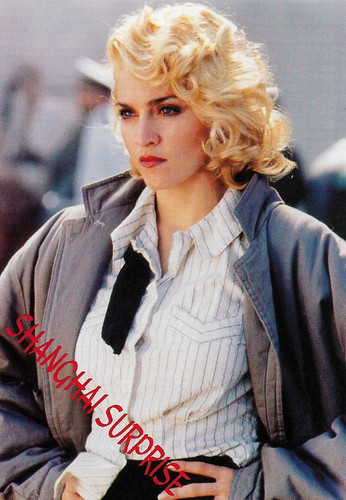
French postcard by Editions Humour à la Carte, Paris, no. A-C 1216. Photo: UGC Distribution. Madonna in Shanghai Surprise (Jim Goddard, 1986).
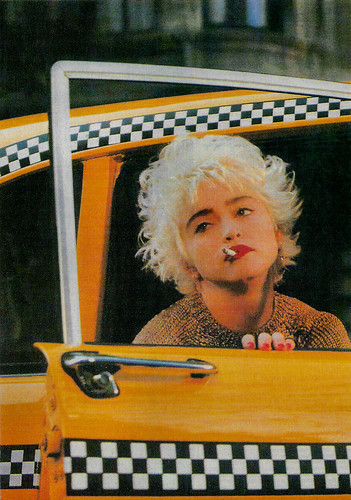
French postcard in the série chanteurs by Les Editions GIL, no. 125. Madonna in Who's That Girl (James Foley, 1987).
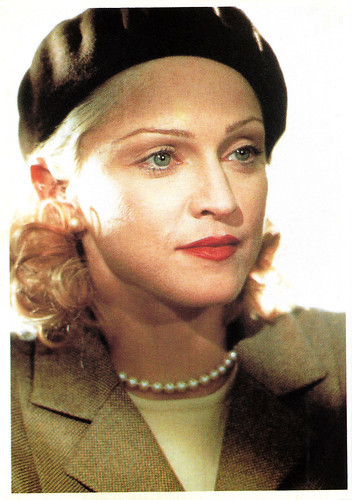
British postcard by Film Review, no. Set E, Card 2. Photo: Guild Film Distribution. Madonna in Body of Evidence (Uli Edel, 1992).
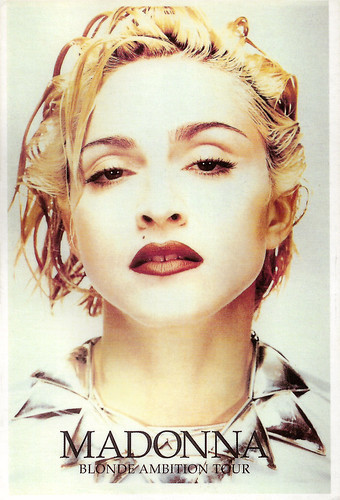
Vintage postcard, no. X334. Caption: Madonna, Blonde Ambition Tour.
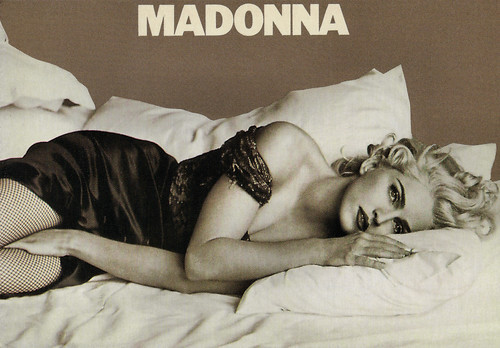
French postcard, no. 1232. Photo: Steven Meisel. Publicity still for Madonna: Truth or Dare/In Bed with Madonna (Alek Keshishian, 1991).
Sources: Phineas Topollino (AllMovie), Wikipedia, and .

French postcard in the 'série chanteurs' by Editions Gil/Edition F. Nugeron, no. 131. Madonna in Desperately Seeking Susan (Susan Seidelman, 1985).

British postcard, no. FA 213. Rosanna Arquette and Madonna in Desperately Seeking Susan (Susan Seidelman, 1985).

French postcard by Editions Humour à la Carte, Paris, no. A-C 1217. Photo: UGC Distribution. Madonna and Sean Penn in Shanghai Surprise (Jim Goddard, 1986).

British postcard New-Line, no. 229. Photo: Madonna and Warren Beatty in Dick Tracy (Warren Beatty, 1990).

Vintage postcard, no. AB 79. Photo: Steven Meisel. Publicity still for Madonna: Truth or Dare/In Bed with Madonna (Alek Keshishian, 1991). Madonna impersonating Jayne Mansfield .
Rosaries and crosses as jewelry and black rubber typewriter bands as bracelets
Madonna was born Madonna Louise Ciccone in 1958 in Bay City, Michigan. Her father is Italian, her mother was French-Canadian. Her siblings are Anthony Ciccone (1956), Martin Ciccone (1957), Paula Ciccone (1959), Christopher Ciccone (1960), and Melanie Henry (1962).
In 1962, Madonna's mother, pregnant with her sixth child, was diagnosed with breast cancer. She delayed treatment until her baby was born, but by that time it was too late. A harrowing, yearlong battle with the disease ensued. She lost her battle with cancer in 1963.
In 1978, Madonna moved to New York and studied with renowned choreographer Alvin Ailey. She joined up with the Patrick Hernandez Revue, formed a pop/dance band called 'Breakfast Club', and began working with then-boyfriend Stephen Bray on recording several disco-oriented songs. New York producer/D.J. Mark Kamins passed her demo tapes to Sire Records in early 1982 and the rest is history.
The 1980s was Madonna's boom decade, and she dominated the music charts with a succession of multimillion-selling albums. Madonna first appeared on screen in two low-budget films marketed to an adolescent audience: A Certain Sacrifice (Stephen Jon Lewicki, 1979) and Crazy for You (Harold Becker, 1985), starring Matthew Modine. Her first film, A Certain Sacrifice (1979), was released in 1985, after she became a star, but was actually shot in two parts, the first in 1979, and the other, in 1981.
However, she scored a minor cult hit with Desperately Seeking Susan (Susan Seidelman, 1985) starring alongside spunky Rosanna Arquette. In 1984, she started fashion trends with her unique look using rosaries and crosses as jewelry and black rubber typewriter bands as bracelets. Legions of adolescent girls mimicked her look and a Madonna clothing store was opened in New York. Again in 2001, another huge fashion trend was set off by the "Material Mom", this time with Western wear - cowboy hats and mud-splattered jeans.
In 1986, she starred with then-husband Sean Penn in Shanghai Surprise (Jim Goddard, 1986), which was savaged by critics. She managed to somewhat improve her standing in the cinema with her next two films, the off-beat Who's That Girl (James Foley, 1987) and the quirky Damon Runyon-inspired Bloodhounds of Broadway (Howard Brookner, 1989).

Dutch promotion card by Verenigde Spaarbank, Utrecht.

British postcard by Santoro Graphics, London, no. BW123. Photo: Steven Meisel. Photo for the cover of the album 'Like a Virgin' (1984).

American postcard Classico, San Francisco / Winterland Productions / Rock Express, no. 460-053. Photo: Herb Ritts / Boy Toy Inc., 1991. Photo for the cover of the album 'True Blue' (1986).

Vintage postcard, no. DK 647. Photo: Steven Meisel.

German postcard by Warner Music Germany. Photo: Mario Testino. Publicity still for the album Ray of Light (1998).

French promotion card. Photo: J. B. Mondino / WEA. The postcard promotes Madonna's album and single 'Music'. The album premiered in France on 18 September 2000 and the single on 22 August 2000.
A Golden Globe for Best Actress
Madonna played in the big-budget and star-filled Dick Tracy (Warren Beatty, 1990) bad girl Breathless Mahoney flirting with Warren Beatty. The epic failed to catch fire at the box office. However, her next film, the tell-all documentary Madonna: Truth or Dare (Alek Keshishian, 1991) which followed on her controversial Blond Ambition tour in 1990, fared much better at the box office. Filmed in black and white, with the concert pieces in colour, it is an intimate look at the work of the music performer, from a prayer circle with the dancers before each performance to bed games with the dance troupe afterwards.
Madonna got good reviews as a feisty baseball player alongside Tom Hanks and Geena Davis in the entertaining A League of Their Own (Penny Marshall, 1992), a story about female baseball players during W.W.II.
Madonna drew the wrath of critics with the whodunnit Body of Evidence (Uli Edel, 1992) with Willem Dafoe, an obvious attempt to cash in on the success of the sexy Sharon Stone thriller Basic Instinct (Paul Verhoeven, 1992). For this pseudo-S&M thriller, her show-and-tell photo book 'Sex', and her subpar dance album 'Erotica' she received a maelstrom of negative publicity.
Several minor screen roles followed, but then Madonna starred as Eva Perón opposite Jonathan Pryce and Antonio Banderas in Evita (Alan Parker, 1996). She received a Golden Globe for Best Actress for her role in this fairly well-received screen adaptation of the hugely successful Broadway musical.
Madonna stayed away from the film cameras for several years. She returned to the screen co-starring with Rupert Everett in the romantic comedy The Next Best Thing (John Schlesinger, 2000), followed by the painfully bad Swept Away (2002) for husband Guy Ritchie. She was again miscast as a vampish fencing instructor in the James Bond adventure Die Another Day (Lee Tamahori, 2002) starring Pierce Brosnan .
In 2008, Madonna began a directing career with the comedy Filth and Wisdom (Madonna, 2008), and a year later she reunited with director Alek Keshishian to develop a script about the relationship between the Duke of Windsor and the Duchess of Windsor that led to his abdication in 1936. The result was the film W.E. (Madonna, 2011), starring James D'Arcy and Andrea Riseborough as the infernal but still royal couple. The film was released in 2011 to lukewarm critics but it gathered one Oscar nomination for costumes. Madonna contributed the ballad 'Masterpiece' for the film's soundtrack, which won her a Golden Globe Award for Best Original Song.
In the following years, Madonna continued to perform and record albums, but her film career seemed over. However, in 2020, Madonna posted a video on her Instagram where she discussed ideas for a script with writer Diablo Cody. Later she confirmed on an Instagram live stream they were writing a film about her life, to be produced by Amy Pascal.
Wikipedia : "With sales of over 300 million records worldwide, Madonna is certified as the best-selling female recording artist of all time by Guinness World Records. She is the most successful solo artist in the history of the US Billboard Hot 100 chart and holds the record for the most number-one singles by a female artist in Australia, Canada, Italy, Spain, and the United Kingdom. With a revenue of U.S. $1.5 billion from her concert tickets, she remains the highest-grossing solo touring artist of all time."
Madonna has 6 children: daughter Lourdes Leon (1996) with ex-boyfriend Carlos Leon, son Rocco Ritchie (2000), and adoptive son, David Banda Mwale Ciccone Ritchie (2005) with ex-husband Guy Ritchie, and three adoptive daughters, Mercy James Ciccone (2006), and the twins Estere Ciccone and Stella Ciccone (2012).

French postcard by Editions Humour à la Carte, Paris, no. ST-56.

English postcard by Anabas, Romford, no. AP182, 1986.

French postcard by Editions Humour à la Carte, Paris, no. A-C 1216. Photo: UGC Distribution. Madonna in Shanghai Surprise (Jim Goddard, 1986).

French postcard in the série chanteurs by Les Editions GIL, no. 125. Madonna in Who's That Girl (James Foley, 1987).

British postcard by Film Review, no. Set E, Card 2. Photo: Guild Film Distribution. Madonna in Body of Evidence (Uli Edel, 1992).

Vintage postcard, no. X334. Caption: Madonna, Blonde Ambition Tour.

French postcard, no. 1232. Photo: Steven Meisel. Publicity still for Madonna: Truth or Dare/In Bed with Madonna (Alek Keshishian, 1991).
Sources: Phineas Topollino (AllMovie), Wikipedia, and .
Published on March 28, 2021 22:00
March 27, 2021
Before Hollywood: Keystone
In the final post of our Before Hollywood series, we present the funniest of the American pioneering studios, Mack Sennett's The Keystone Film Company. In 1912, Sennett and two producers formed the company. Sennett brought Mabel Normand with him and soon hired Roscoe 'Fatty' Arbuckle, Chester Conklin, Minta Durfee, and Charles Chaplin. To the slapstick chase gags of the Keystone Cops, the Bathing Beauties and the Kid Comedies were gradually added. Sennett, D.W. Griffith, and Thomas H. Ince formed Triangle Films in 1915. Actors like Bobby Vernon and Gloria Swanson joined them. In 1917, Triangle went bankrupt and Sennett formed Mack Sennett Comedies. Keystone finally ended in 1937.

British postcard in the series "Keystone cards presented with Home Weekly". Photo: Keystone Film. Mabel Normand in The Sea Nymphs (Mack Sennett, 1914). Caption: Mabel as a sea nymph.
Mabel Normand (1892-1930) was a popular American silent film comedienne. In 1912, director Mack Sennett discovered her and took her to his new studio, Keystone in California. At the start, Normand was primarily portrayed in films as a beautiful woman, but soon her talent for comedy was spotted. She became a highly popular comedienne in shorts with Charlie Chaplin and Fatty Arbuckle. In 1916, Normand opened with Sennett her own company at Culver City, as a subsidiary of Triangle. When Triangle collapsed in 1918 it also took down Mabel's company and also caused Sennett to lose Keystone. In 1918 also the affair of Normand with Sennett ended.
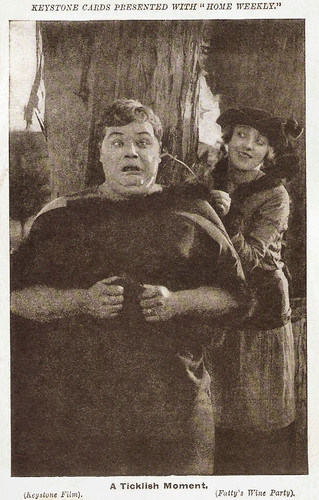
British postcard in the series "Keystone cards presented with Home Weekly". Photo: Keystone Film. Fatty Arbuckle and Mabel Normand in Fatty's Wine Party (Roscoe 'Fatty' Arbuckle, 1914). Caption: A Ticklish Moment.
American silent film actor, comedian Roscoe ‘Fatty’ Arbuckle (1887-1933) was one of the most popular silent stars of the 1910s. In 1913, Arbuckle went to work in producer-director Mack Sennett's Keystone Cops comedies. His character Fatty – he weighed 135 kilograms at the height of his career - usually wore bowler-hat and pants whose legs were too short. For the next 3-1/2 years, he appeared in hundreds of one-reel comedies, mostly as policemen, but he also played different parts. He would work with Mabel Normand, Ford Sterling, and others, and would learn about the process of making films from Henry Lehrman, who directed all but two of his pictures. Despite his massive physical size, Arbuckle was remarkably agile and acrobatic. His comedies are noted as rollicking and fast-paced, have many chase scenes, and feature sight gags. Arbuckle was fond of the ‘pie in the face’, a comedy cliché that has come to symbolize silent-film-era comedy itself. The earliest known custard pie thrown in a film was in the Keystone one-reeler A Noise from the Deep (Mack Sennett, 1913). The pie was thrown by Mabel Normand and Arbuckle was the recipient.

British postcard in the series "Keystone cards presented with Home Weekly". Photo: Keystone Film. Chester Conklin and Minta Durfee in A Bird's A Bird (Walter Wright, 1915).
American comedian Chester Conklin (1886-1971) developed for vaudeville his comedy character with a thick accent and a very bushy walrus-type mustache, which was patterned after his former boss, a German baker named Schultz. After seeing several of Mack Sennett's Keystone Cops shorts, Conklin applied for a job and stayed with Sennett for six years. Conklin became famous for his pairing with burly comic Mack Swain in a series of Ambrose and Walrus shorts. He also appeared in several of Charles Chaplin's shorts for the studio.
American comedienne Minta Durfee (1889-1975) began her career on stage in 1908 as a chorus girl in musical revues. She married comedian Roscoe 'Fatty' Arbuckle. In 1914, they entered Keystone and were soon a comedy double. Minta became Chaplin's leading lady in the two-reeler Making a Living (1914). In addition to the series of 'Fatty' featurettes, Minta also worked at Keystone in the classic madcap farce Tillie's Punctured Romance (1914) and co-starred opposite Chester Conklin, Mack Swain, and Ford Sterling in a series of outrageous daredevil comedies until 1916.
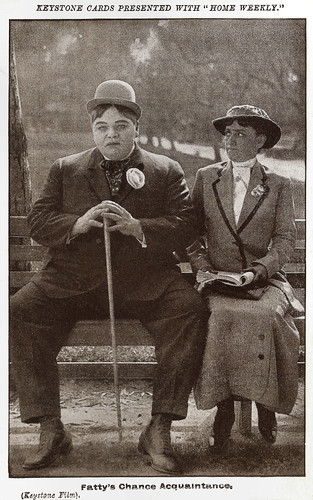
British postcard in the series "Keystone cards presented with Home Weekly". Photo: Keystone Film. Fatty Arbuckle and Billie Bennett in Fatty's Chance Acquaintance (Roscoe 'Fatty' Arbuckle, 1915).
The first totally enclosed film stage and studio in history
'The Keystone Pictures Studio' was founded by director Mack Sennett (1880-1960) under that name on 4 July 1912 in Edendale, California, which is now a part of Echo Park. Mack Sennett's backers were actor-writer Adam Kessel (1866–1946) and Charles O. Baumann (1874–1931), who were the owners of the New York Motion Picture Company, founded 1909.
The name Keystone was taken from the side of one of the cars of a passing Pennsylvania Railroad train (Keystone State being the nickname of the Commonwealth of Pennsylvania) during the initial meeting of Sennett, Kessel, and Baumann in New York.
The company referred to at its office as The Keystone Film Company, filmed in and around Glendale and Silver Lake, Los Angeles for several years, and its films were distributed by the Mutual Film Corporation between 1912 and 1915.
In 1912, Sennett created the slapstick antics of the Keystone Cops, and in 1915, he started the Sennett Bathing Beauties. Charlie Chaplin got his start at Keystone when Sennett hired him fresh from his Vaudeville career to make silent films. Sennett directed Chaplin in 35 comedies during 1914. He told Chaplin, "We have no scenario - we get an idea, then follow the natural sequence of events until it leads up to a chase, which is the essence of our comedy."
Many other important actors also worked at Keystone toward the beginning of their film careers, including Marie Dressler, Harold Lloyd , Mabel Normand, Roscoe 'Fatty' Arbuckle , Gloria Swanson , Louise Fazenda, Raymond Griffith, Ford Sterling, Minta Durfee, Ben Turpin, Harry Langdon, Al St. John, and Chester Conklin.
In 1915, Keystone Studios became an autonomous production unit of the Triangle Film Corporation with D. W. Griffith and Thomas Ince. Comedy moved from improvisational slapstick to scripted situations. In 1917, Sennett, by then a celebrity, departed the studio in 1917 to produce his own independent films, which were eventually distributed through Paramount and later through Pathé.
Keystone's business decreased after Mack Sennett's departure, and the company finally closed after bankruptcy in 1935. The original main building of the studio, the first totally enclosed film stage, and studio in history, is still standing. It is located at 1712 Glendale Blvd in Echo Park, Los Angeles, and is now being used as a storage facility.
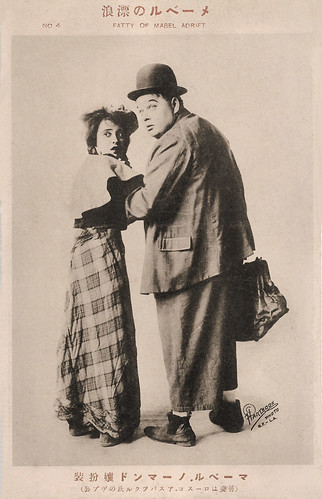
Chinese postcard, no. 4. Photo: Hartsook Photo, S.F. - L.A. / Keystone Film. Fatty Arbuckle and Mabel Normand in Fatty and Mabel Adrift (Roscoe 'Fatty' Arbuckle, 1916).
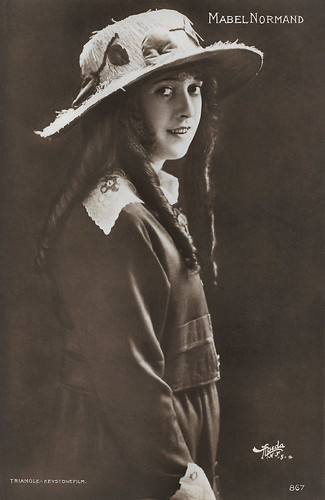
Mabel Normand. Swedish postcard by Förlag Nordisk Konst, Stockholm, no. 867. Photo: Apeda N.Y. / Triangle-Keystone Films.
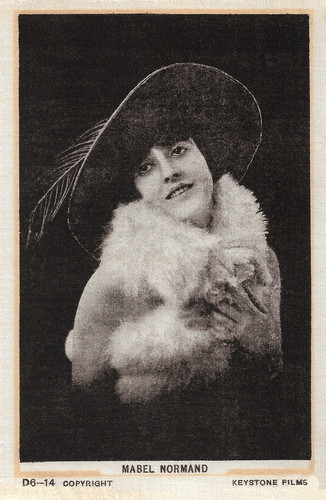
Mabel Normand. British postcard in the Novelty Series, no. D6-14. Photo: Keystone Films.
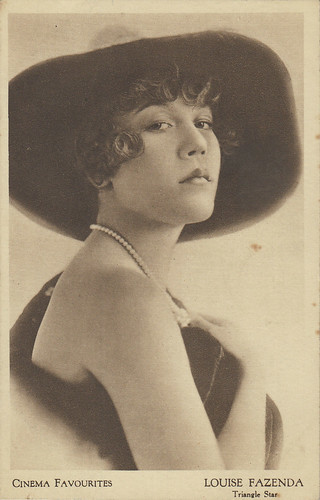
British postcard by Photochrom Co. Ltd., London no. 111. Photo: Triangle / Keystone. Collection: Marlene Pilaete.
Louise Fazenda (1895-1962) was a gawky, highly popular funny girl in slapstick comedies for Keystone Studios. She paired up well with comedian Charlie Murray. Her best-known character was her country bumpkin - complete with spit curls, multiple pigtails, and calico dresses. In the early 1920s, Louise left Sennett's company and progressed to feature films, where her eccentric talents were greatly utilised in musicals and knockabout comedies.
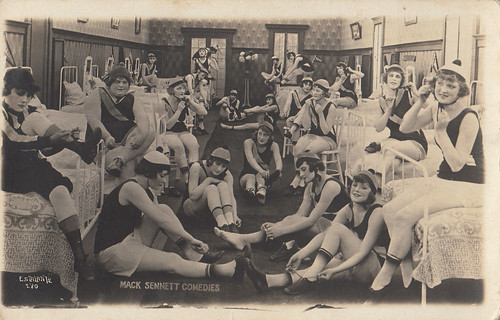
Vintage postcard by Estalante, no. 280. Photo: Mack Sennett Comedies. At left Gloria Swanson . Collection: Marlene Pilaete.
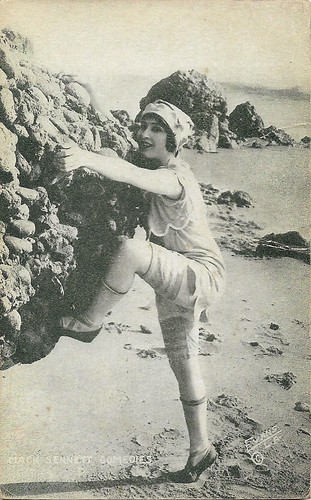
American postcard. Photo: Evans, Los Angeles / Mack Sennett Comedies. One of Mack Sennett's bathing beauties.
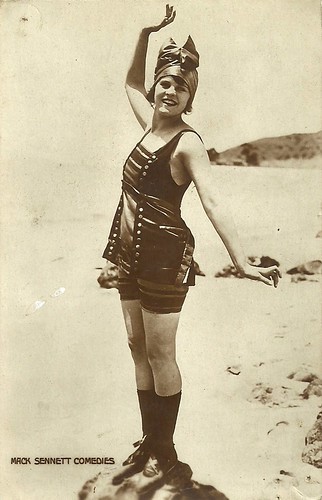
French postcard by Cinémagazine Edition. Photo: Mack Sennett Comedies.
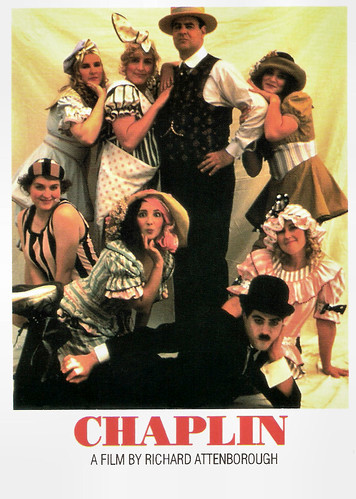
French postcard by Editions Mercuri, no. 817. Photo: Tri-Star Pictures. Publicity still for Chaplin (Richard Attenborough, 1992) with Dan Aykroyd as Mack Sennett and Robert Downey Jr. as Charlie Chaplin between Sennett's Bathing Beauties.
Sources: Wikipedia and .
Check out our earlier Before Hollywood posts: Vitagraph, Essanay, Biograph, Lubin, Flying A, Kalem, Edison, and Selig.

British postcard in the series "Keystone cards presented with Home Weekly". Photo: Keystone Film. Mabel Normand in The Sea Nymphs (Mack Sennett, 1914). Caption: Mabel as a sea nymph.
Mabel Normand (1892-1930) was a popular American silent film comedienne. In 1912, director Mack Sennett discovered her and took her to his new studio, Keystone in California. At the start, Normand was primarily portrayed in films as a beautiful woman, but soon her talent for comedy was spotted. She became a highly popular comedienne in shorts with Charlie Chaplin and Fatty Arbuckle. In 1916, Normand opened with Sennett her own company at Culver City, as a subsidiary of Triangle. When Triangle collapsed in 1918 it also took down Mabel's company and also caused Sennett to lose Keystone. In 1918 also the affair of Normand with Sennett ended.

British postcard in the series "Keystone cards presented with Home Weekly". Photo: Keystone Film. Fatty Arbuckle and Mabel Normand in Fatty's Wine Party (Roscoe 'Fatty' Arbuckle, 1914). Caption: A Ticklish Moment.
American silent film actor, comedian Roscoe ‘Fatty’ Arbuckle (1887-1933) was one of the most popular silent stars of the 1910s. In 1913, Arbuckle went to work in producer-director Mack Sennett's Keystone Cops comedies. His character Fatty – he weighed 135 kilograms at the height of his career - usually wore bowler-hat and pants whose legs were too short. For the next 3-1/2 years, he appeared in hundreds of one-reel comedies, mostly as policemen, but he also played different parts. He would work with Mabel Normand, Ford Sterling, and others, and would learn about the process of making films from Henry Lehrman, who directed all but two of his pictures. Despite his massive physical size, Arbuckle was remarkably agile and acrobatic. His comedies are noted as rollicking and fast-paced, have many chase scenes, and feature sight gags. Arbuckle was fond of the ‘pie in the face’, a comedy cliché that has come to symbolize silent-film-era comedy itself. The earliest known custard pie thrown in a film was in the Keystone one-reeler A Noise from the Deep (Mack Sennett, 1913). The pie was thrown by Mabel Normand and Arbuckle was the recipient.

British postcard in the series "Keystone cards presented with Home Weekly". Photo: Keystone Film. Chester Conklin and Minta Durfee in A Bird's A Bird (Walter Wright, 1915).
American comedian Chester Conklin (1886-1971) developed for vaudeville his comedy character with a thick accent and a very bushy walrus-type mustache, which was patterned after his former boss, a German baker named Schultz. After seeing several of Mack Sennett's Keystone Cops shorts, Conklin applied for a job and stayed with Sennett for six years. Conklin became famous for his pairing with burly comic Mack Swain in a series of Ambrose and Walrus shorts. He also appeared in several of Charles Chaplin's shorts for the studio.
American comedienne Minta Durfee (1889-1975) began her career on stage in 1908 as a chorus girl in musical revues. She married comedian Roscoe 'Fatty' Arbuckle. In 1914, they entered Keystone and were soon a comedy double. Minta became Chaplin's leading lady in the two-reeler Making a Living (1914). In addition to the series of 'Fatty' featurettes, Minta also worked at Keystone in the classic madcap farce Tillie's Punctured Romance (1914) and co-starred opposite Chester Conklin, Mack Swain, and Ford Sterling in a series of outrageous daredevil comedies until 1916.

British postcard in the series "Keystone cards presented with Home Weekly". Photo: Keystone Film. Fatty Arbuckle and Billie Bennett in Fatty's Chance Acquaintance (Roscoe 'Fatty' Arbuckle, 1915).
The first totally enclosed film stage and studio in history
'The Keystone Pictures Studio' was founded by director Mack Sennett (1880-1960) under that name on 4 July 1912 in Edendale, California, which is now a part of Echo Park. Mack Sennett's backers were actor-writer Adam Kessel (1866–1946) and Charles O. Baumann (1874–1931), who were the owners of the New York Motion Picture Company, founded 1909.
The name Keystone was taken from the side of one of the cars of a passing Pennsylvania Railroad train (Keystone State being the nickname of the Commonwealth of Pennsylvania) during the initial meeting of Sennett, Kessel, and Baumann in New York.
The company referred to at its office as The Keystone Film Company, filmed in and around Glendale and Silver Lake, Los Angeles for several years, and its films were distributed by the Mutual Film Corporation between 1912 and 1915.
In 1912, Sennett created the slapstick antics of the Keystone Cops, and in 1915, he started the Sennett Bathing Beauties. Charlie Chaplin got his start at Keystone when Sennett hired him fresh from his Vaudeville career to make silent films. Sennett directed Chaplin in 35 comedies during 1914. He told Chaplin, "We have no scenario - we get an idea, then follow the natural sequence of events until it leads up to a chase, which is the essence of our comedy."
Many other important actors also worked at Keystone toward the beginning of their film careers, including Marie Dressler, Harold Lloyd , Mabel Normand, Roscoe 'Fatty' Arbuckle , Gloria Swanson , Louise Fazenda, Raymond Griffith, Ford Sterling, Minta Durfee, Ben Turpin, Harry Langdon, Al St. John, and Chester Conklin.
In 1915, Keystone Studios became an autonomous production unit of the Triangle Film Corporation with D. W. Griffith and Thomas Ince. Comedy moved from improvisational slapstick to scripted situations. In 1917, Sennett, by then a celebrity, departed the studio in 1917 to produce his own independent films, which were eventually distributed through Paramount and later through Pathé.
Keystone's business decreased after Mack Sennett's departure, and the company finally closed after bankruptcy in 1935. The original main building of the studio, the first totally enclosed film stage, and studio in history, is still standing. It is located at 1712 Glendale Blvd in Echo Park, Los Angeles, and is now being used as a storage facility.

Chinese postcard, no. 4. Photo: Hartsook Photo, S.F. - L.A. / Keystone Film. Fatty Arbuckle and Mabel Normand in Fatty and Mabel Adrift (Roscoe 'Fatty' Arbuckle, 1916).

Mabel Normand. Swedish postcard by Förlag Nordisk Konst, Stockholm, no. 867. Photo: Apeda N.Y. / Triangle-Keystone Films.

Mabel Normand. British postcard in the Novelty Series, no. D6-14. Photo: Keystone Films.

British postcard by Photochrom Co. Ltd., London no. 111. Photo: Triangle / Keystone. Collection: Marlene Pilaete.
Louise Fazenda (1895-1962) was a gawky, highly popular funny girl in slapstick comedies for Keystone Studios. She paired up well with comedian Charlie Murray. Her best-known character was her country bumpkin - complete with spit curls, multiple pigtails, and calico dresses. In the early 1920s, Louise left Sennett's company and progressed to feature films, where her eccentric talents were greatly utilised in musicals and knockabout comedies.

Vintage postcard by Estalante, no. 280. Photo: Mack Sennett Comedies. At left Gloria Swanson . Collection: Marlene Pilaete.

American postcard. Photo: Evans, Los Angeles / Mack Sennett Comedies. One of Mack Sennett's bathing beauties.

French postcard by Cinémagazine Edition. Photo: Mack Sennett Comedies.

French postcard by Editions Mercuri, no. 817. Photo: Tri-Star Pictures. Publicity still for Chaplin (Richard Attenborough, 1992) with Dan Aykroyd as Mack Sennett and Robert Downey Jr. as Charlie Chaplin between Sennett's Bathing Beauties.
Sources: Wikipedia and .
Check out our earlier Before Hollywood posts: Vitagraph, Essanay, Biograph, Lubin, Flying A, Kalem, Edison, and Selig.
Published on March 27, 2021 22:00
March 26, 2021
Cinema Paradiso
Remember going to the movies? We like to binge-watch Netflix and Prime during the lockdown, but we do miss the unique experience of going to a cinema. We love to visit the 'bioscoop', the 'kino', the movie palaces anywhere in the world, and to see a great film on a big screen with an audience that's laughing and crying. It seems like a forbidden paradise today. On her blog Cinepostcards, Jane Melichar writes: "I love the surreal reality of cinemas, a familiar place that sends me to strange places, a journey into the world and into me. This adventure starts around the corner." We agree so much. So, here are 25 postcards (plus a vintage photo) of cinemas which we collected through the years.
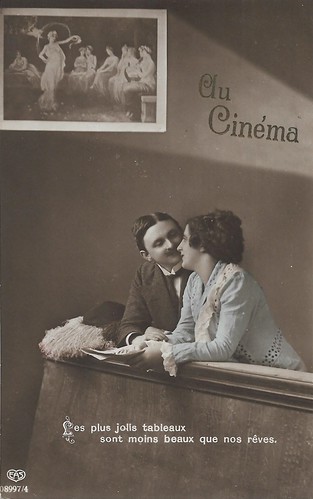
French postcard by EAS, no. 08997/4. EAS stands for E.A. Schwerdtfeger, a German postcard publisher. Caption: Au Cinéma. Les plus jolis tableaux sont moins beaux que nos rêves (At the cinema. The most beautiful scenes are less beautiful than our dreams).
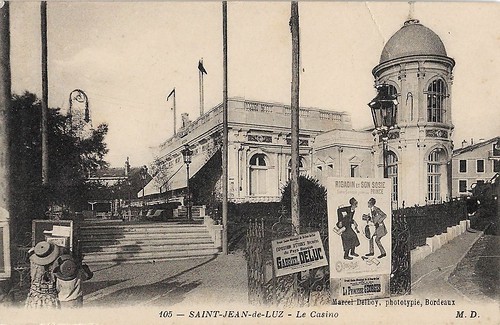
French postcard by M.D.(Phototypie Marcel Delboy, Bordeaux), no. 105. Caption: Saint-Jean-de-Luz, Le Casino.
A French poster for the silent comedy Rigadin et son sosie/Whiffle's Double (Georges Monca, Pathé Frères 1910), starring Prince. In front of the Casino, Saint-Jean-de-Luz, where the film apparently was shown.
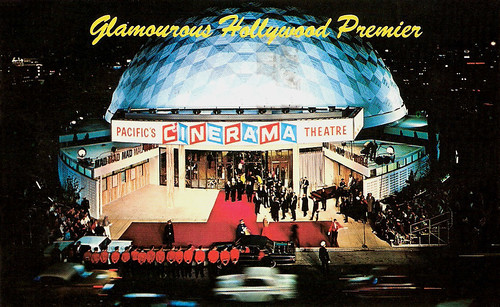
American postcard by Mitock & Sons, North Hollywood, California. Color by Bert Kaltman / Plastichrome, Boston. The picture was taken at the premiere of It's a Mad Mad Mad Mad World (Stanley Kramer, 1963). This postcard was sent from Mexico to Italy. We bought it in the USA and it's now in our collection in the Netherlands.
Pacific's Cinerama Theatre is "The Only Theatre Of Its Kind In The World", boasts the card's publisher at the backside of the card. "Located in Cinerama Center, Sunset and Ivar, Hollywood, it's the first geodesic dome in concrete anywhere in the world. It is the first major theatre built in Hollywood in 35 years. It is an endless network of electronic marvels. Gold is the dominant color in the richly fabricated carpeting and drapes. Striking innovations in lightning and luxurious seating provide unbelievable comfort and beauty."
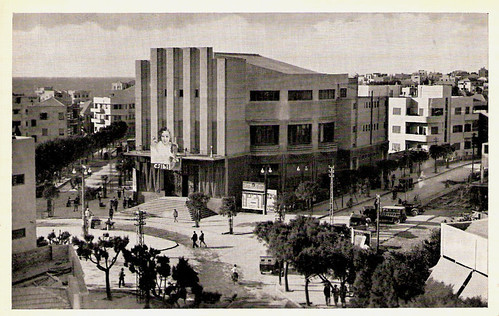
Vintage Czech postcard.
The former Mugrabi cinema (Kolnoa Mograbi) in Tel Aviv, Israël was located at the Kikar Bet BeNovember aka 'Mugrabi Square' near Allenby Road and Ben Yehuda Street. It was also known as Mograbi or Moograbi Opera House and as Mugrabi/Mograbi/Moograbi Hall. It was designed by architect Yosef Berlin in an art deco style that was popular in cinemas worldwide. The building was roofless for the first few years and was eventually stopped with a sliding roof. The cinema opened in 1930, and in the 1940s, it was home to the Palestine Folk Opera company. People gathered in front of the theater to dance in the streets when the UN General Assembly voted in favor of the Partition Plan in November 1947. Later it was again used as a cinema. It was a key cultural icon of Tel Aviv. If you wanted to locate yourself in the city, it was always in relation to the Mugrabi. After a fire in the summer of 1986 due to an electric short-circuit, the building was demolished. It is now a car park.
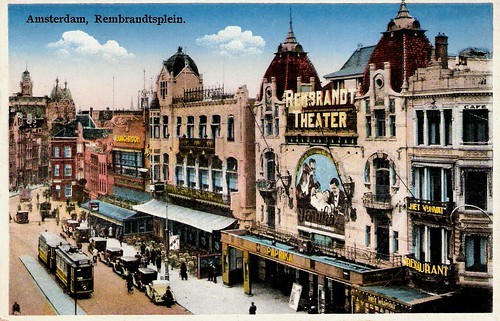
Dutch postcard. This picture of the former Rembrandt Theater in Amsterdam probably dates from 1932. That year the film Paprika was shown here. It was a German comedy directed by Carl Boese and starring the Hungarian star Franciska Gaal and German actor Paul Hörbiger. On the left side in the background, the postcard shows another famous Amsterdam cinema, the Tuschinski Theater.
The Rembrandt Theater was designed in Art Nouveau or Jugendstil style in 1902 by the architects Evert Breman and Willem Molenbroek. It started as a theatre for operettas but in 1919 it was renovated and changed into a cinema. There were 1200 seats. It became the main Dutch venue for the films of the German Ufa studio and many big billboards covered the front of the cinema. In 1940 the cinema suddenly burned down. Years later it was known that the fire was an act of the Dutch resistance. The cinema was never rebuilt and at the location at the Rembrandtplein (Rembrandt Square), 21-23 in the heart of Amsterdam is now a hotel.
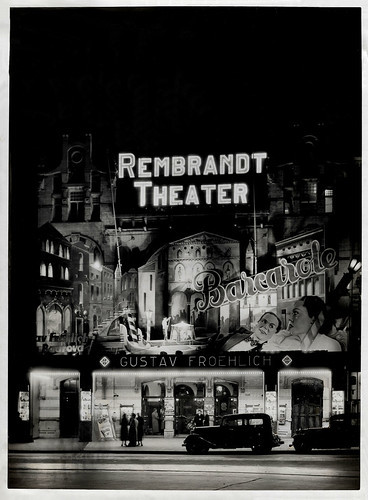
Dutch photo. Front of the Rembrandt Theater in Amsterdam, The Netherlands. On show was Barcarole (Gerhard Lamprecht, 1936), starring Gustav Froehlich and Lyda Baarova. A gift by Roloff de Jeu.
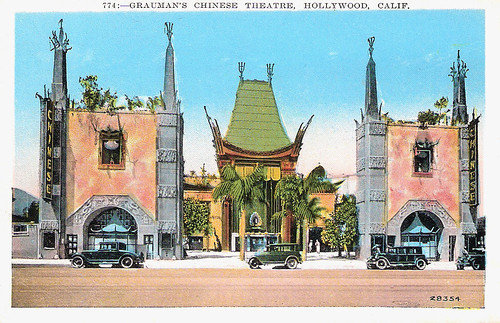
Vintage postcard, no. 774. Grauman's Chinese Theatre, Los Angeles, USA.
Grauman's Chinese Theatre, now TCL Chinese Theatre, is a movie palace on the historic Hollywood Walk of Fame at 6925 Hollywood Blvd. in Hollywood, Los Angeles. The original Chinese Theatre was commissioned following the success of the nearby Grauman's Egyptian Theatre, which opened in 1922. Both are in Exotic Revival style architecture. Built by a partnership headed by Sid Grauman over 18 months starting in January 1926, the theatre opened 18 May 1927, with the premiere of Cecil B. DeMille's The King of Kings. It has since been home to many premieres. Among the theatre's most distinctive features are the concrete blocks set in the forecourt, which bear the signatures, footprints, and handprints of popular motion picture personalities from the 1920s to the present day. The in 2013 renovated theatre seats 932 people and features one of the largest movie screens in North America.
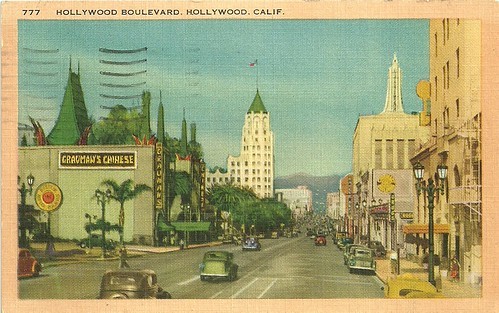
Longshaw Card Co., Los Angeles. Hollywood Boulevard around 1950.
This card was mailed in 1950. Left Grauman's Chinese Theatre. To the right the El Capitan cinema with the sign on the roof. In the middle, the high tower of the First National Bank (1928) by architects Meyer and Holler, still existing. The front right might be the entrance to the Roosevelt Hotel.
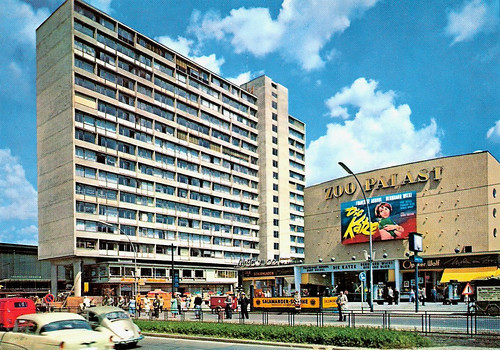
German postcard by Krüger, no. 921/10.
We once visited Zoo Palast, when it used to be one of the locations for the Berlin Film Festival. In 2011, the legendary cinema at the Hardenbergstraße in West-Berlin was closed. It was quite a shock to read this on Wikipedia. The Zoo Palast was built in 1956, but at the site, there had been a Palasttheater am Zoo since 1915. In 1925 the Ufa overtook and rebuilt the cinema. Many classics of the German film had their premiere here, including Metropolis in 1927. The cinema had its own orchestra, a ballet, and a cinema organ.
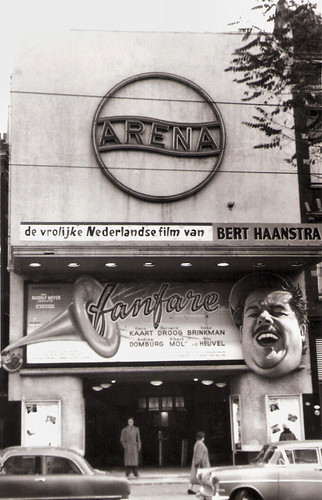
Dutch postcard by A. de Herder, Rotterdam. The Arena Cinema was located at the Kruiskade, Rotterdam, The Netherlands. The presented film was the Dutch comedy Fanfare (Bert Haanstra, 1958), starring Hans Kaart.
After the success with his W.B Theater on the Nieuwe Binnenweg, Karl Weisbard decided in 1930 to open a second cinema on the Kruiskade: Roxy Theater. The building was designed by Jac Van Gelderen. The cinema had 1000 seats and opened on 31 May 1930. In addition to films, small operettas were performed. In 1936, Karl Weisband sold the theatre to Ed Spits who converted it into Arena. During the war, only theatre performances took place, but from 1945 the showing of films was resumed. In 1988 Arena changed into the disco/music venue Nighttown, which went bankrupt in 2006. Since 2013, it is a supermarket.
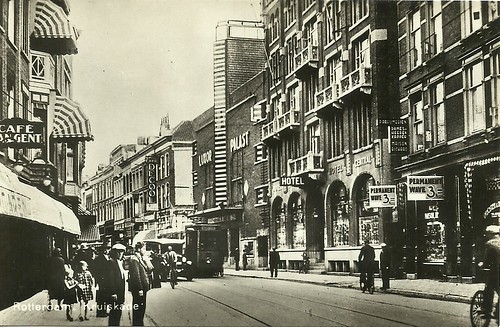
Dutch postcard, Sparo. Rotterdam, Kruiskade with Luxor cinema.
Cinema Luxor in Rotterdam, The Netherlands, was built in 1917 by architect P.J. Vermaas and could hold 1200 seats then. It was the first really big film theatre in town. Luxor opened with the Dutch film Gloria Transita by Johan Gildemeijer. It was an opera film with live song performances by renowned Dutch singers such as Louis Morisson and Emil van Bosch. Around 1918-1919 it became a Dutch film theatre for the German Ufa films, that's why there are the German letters 'Palast' German for Palace) on the facade. The takeover was first secretly done by middlemen as Germany had lost the war of 1914-1918, but by 1926 the Dutch branch of the Ufa company became officially proprietor (until 1938).In 1928 Luxor was remodelled by architect J. van Wijngaarden. Luxor miraculously survived the Rotterdam bombardment and subsequent fires of May 1940. After the war, it was for years property of the Rotterdamsche Kunststichting (the Rotterdam Art Council), who ran it as a cinema, but slowly it became more and more mixed with theatre and Vaudeville. In the early 1970s, Luxor got a radical make-over, losing most if its old elements; the number of chairs went down to 900. Luxor closed down as a cinema in 1985.
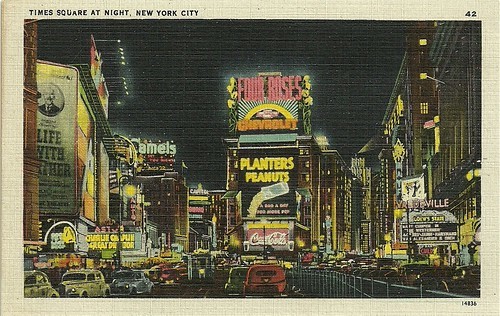
American postcard. Times Square at Night, New York City, c. 1940-1941.
Down at left the marquee of the Astor Theatre indicates that Chaplin's The Great Dictator was screened, which had its New York premiere on October 1940. The Astor opened in 1905 as a legitimate theatre but became mostly a cinema from 1925 on. Top left publicity for the play 'Life with Father' which opened on Broadway, New York, in 1939; it was turned into a film in 1947. Down at right Loew's State Theatre, where Gary Cooper can be seen in The Westerner (1940). Loew's State Theatre opened in 1921 and showed both Vaudeville and cinema.
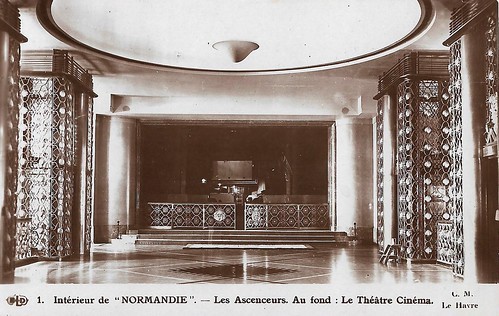
French postcard by BLD, no. 1. Photo: C.M., Le Havre. Caption: Interior of the Normandie. The Elevators. In the back: The theatre/cinema.
When entering into service in 1935, the French ocean liner Normandie was the biggest and fastest ocean liner in the world. Despite its commercial misfortune (the French state heavily subsidised it), Normandie's novel design and lavish interiors in Art Déco and Streamline Moderne Style led many to consider her the greatest of ocean liners.
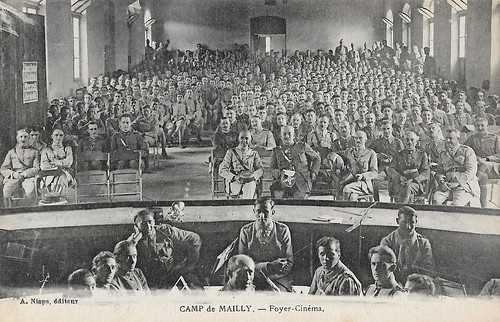
French postcard by A. Nieps edit. Caption: Camp de Mailly, Foyer-Cinéma.
Seen from the podium, the French army visiting a temporary cinema at Camp de Mailly, poses for the photographer. The photo was made during the First World War. Mark the military orchestra in the pit in the foreground, accompanying the silent films. Camp de Mailly was a training camp for the military, founded in 1902, and most active during the Great War, in particular for training and equipping the Russian expeditionary force in France.
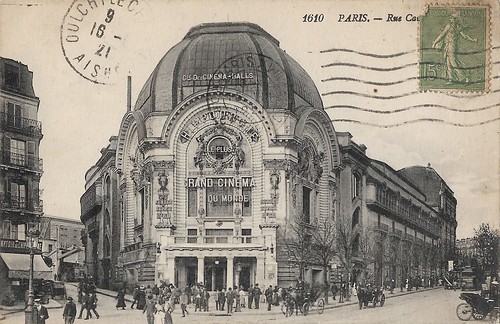
French postcard, no. 1610. Caption: Rue Caulaincourt, Paris. Sent by mail in 1921.
This building was created 1898-1900 as the Hippodrome Montmartre. In 1911 film producer Léon Gaumont took it over, restyled it, and turned it into the Gaumont-Palace. With its supposed 3000 seats, it was the biggest cinema in the world then (mark the letters on the facade 'Le plus grand cinéma du monde'). The Gaumont company also had its headquarters here. In 1931 Gaumont built a completely new cinema on the site, which hosted seats for 6000 persons, and was well equipped for sound film. In the 1960s it was a major Cinerama cinema, but in the early 1970s it closed down and in 1973 it was destroyed. Only by speedy handling, the French Cinematheque managed to save Leon Gaumont's personal archive, as workers had fast thrown outside all that was in the building. A vast part of the business archive thus must have been gone lost.
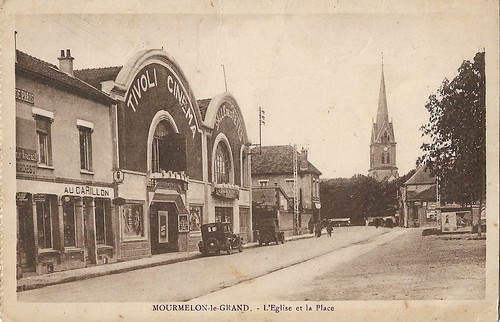
French postcard. Mourmelon-le-Grand (Marne), church and main square, left the cinema Tivoli and Salle des Fêtes. Probably 1920s.
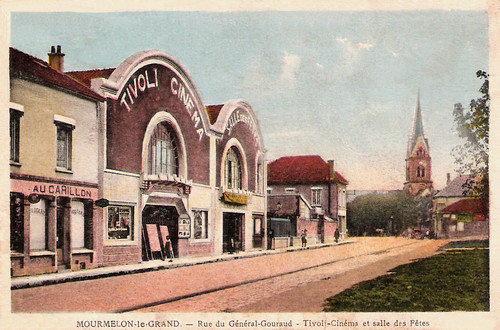
French postcard by Librairie Militaire Guérin, Nourmelon-Le-Grand. Sent by mail in 1932. Tivoli Cinema, Mourmelon-Le-Grand, France.
The Tivoli Cinema was opened in 1932, according to the great database Cinema Treasures. It operated into at least the 1950s. It has since been demolished and apartments have been built on the site. However, Gerald A. DeLuca comments at the site: "Judging from the postcards, this is probably a pre-World War I cinema. The color-tinted one shows a poster for the film Sans famille, probably the 1913 version rather than the 1925 version." We agree with Gerald.
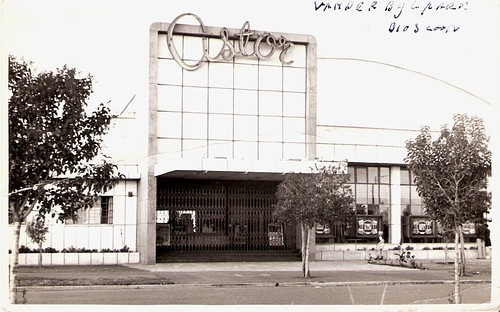
A picture of the Astor cinema in Vanderbijlpark, a city in Transvaal in South-Africa. The photo was sent as a postcard by a kid to his grandparents in the Netherlands. Maybe he is the kid standing in front of the cinema at the right?
Today, Vanderbijlpark town doesn't have a cinema anymore. Our sources, like Cinema Treasures, don't mention this cinema, but this photo of the Astor proves there used to be a cinema in Vanderbijlpark, once at a time.
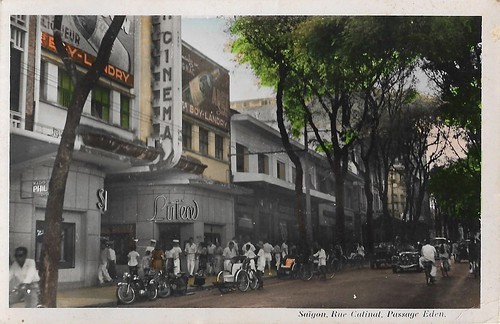
French postcard, no. 93. Photo: Nam Phat, Saigon. Saïgon, Rue Catinal, Passage Eden, Cinema Eden.
The Eden building in Saigon (now Ho Chi Minh City), Vietnam, was built in 1947 and demolished in 2010, to make a place for a mall. The complex hosted the much older Cinema Eden, which in the 1920s was frequented by Europeans but later on was a popular hotspot for the Vietnamese population.
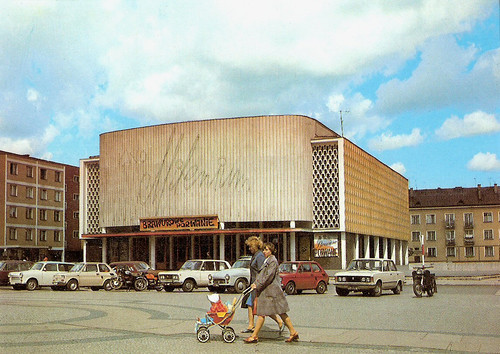
Polish postcard by Krajowa Agencja Wydawnicza. Photo: J. Tymínski - KAW. Kino Milenium, Slupsk, Poland.
Cinema Milenium in Słupsk - the name points to the future of cinematography - opened in 1963. It was one of the first in Poland to have a Cinerama. It belonged to the ten most important cinemas in Poland. The cinema inaugurated its activity on 4 April 1963 with a screening of the Polish film Zerwany most (Jerzy Passendorfer, 1962). Initially, the Milenium cinema had 724 seats in the auditorium, but their number decreased slightly after subsequent renovations and as a result of enlarging the stage. At the beginning of the 1970s, the number of seats was reduced to 640, in 1979 the reclining seats were replaced with new ones, and in 1999 another renovation and modernisation of the stage forced the number of seats to be reduced to 600. On 16 December 2000, the cinema showed its last film: Zerwany most. Now there is a supermarket in this building.
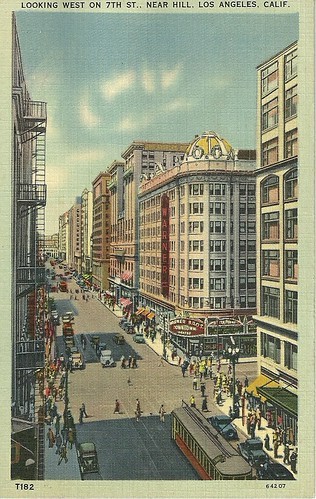
American postcard. Los Angeles, 7th Street/Hill Street, Warner Bros. Theatre Downtown.
Originally opened in 1920 as the Pantages Theatre, it later became the Downtown Warner Theatre (until the mid-1960s) and lastly the Warren Theatre (late 1960s and 1970s). Later a church, now a retail shop for the Jewelry Exchange. While the ground floor and podium disappeared, the proscenium arch balcony and ceiling are still there. No pictures allowed inside, but visitable with the Conservancy tour. See our Flickr site for a snapshot we took in 2010.
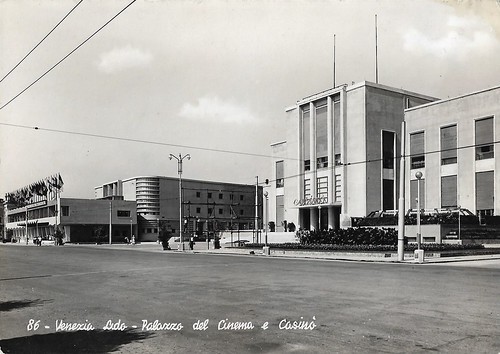
Italian postcard, no. 86. Venice, Lido, Palazzo del Cinema (left) and Casino (right), 1950s.
The Palazzo del Cinema was constructed in 1937 in record time to host the 5th edition of the Venice Film Festival. The architect was Luigi Quagliata, while next door Luigi Miozzi constructed the Summer Casino of Venice. In recent years the Palazzo del Cinema has expanded in several ways and also annexed the space of the Casino. Yet, the very ambitious plans for total makeover and demolition of existing structures mostly failed, over and again.
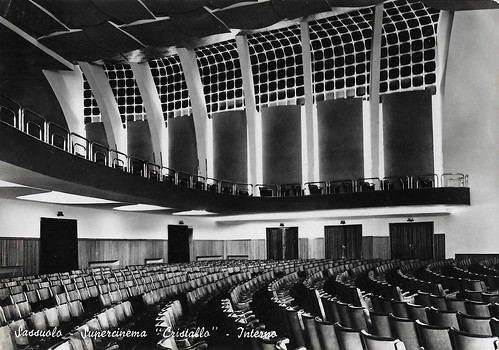
Italian postcard by Fotocelere. Caption: Sassuolo - Supercinema "Cristallo" - Interno.
The interior of the Supercinema Cristallo in Sassuolo in the province of Modena, Italy, probably in the 1950s. The cinema closed and was demolished.
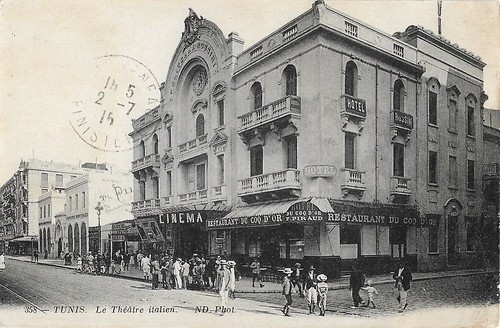
French postcard by ND Phot., no. 358. Caption: Tunis, The Italian Theatre. The card was mailed in 1915.
The Politeama Rossini in Tunis was indicated here as The Italian Theatre. Politeama was an Italian denomination for a multifunctional entertainment building, combing cinema, theater, and other forms of leisure. The Politeama Rossini in Tunis opened in 1903. It catered to the Italian community in Tunis and competed with the City Theater, which had opened at the end of 1902. In 1923 it was sold and became storage. Later on, it became a cinema only. It still exists as the cinema Le Palace. Its facade was reconstructed in 2002 after it was destroyed during the embellishment of Avenue Bourguiba.
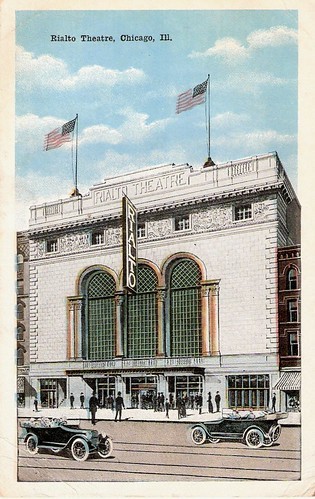
American postcard by E.C. Kropp Co., Milwaukee, no. 18088. Caption: "Jones, Linick & Schaefer's Rialto Theatre, State St., between Jackson and Van Buren. Finest Vaudeville Theatre in Chicago."
The Rialto Theatre in Chicago, Il., USA, was opened in 1917 as a venue for Vaudeville and films, near the corner of State and Van Buren Streets in Chicago. The Rialto could seat over 1500. The theatre was designed by the architectural duo of Marshall & Fox, who also designed the earlier legitimate Blackstone Theatre (now the Merle Reskin), the Blackstone Hotel, and, later, Chicago's famed Drake Hotel. This mid-sized venue was located directly across the street from the neo-classical department store building that began its life as Rothschild's, then the Davis Store, then Goldblatt's and is today the Loop campus of DePaul University. Later the Rialto Theatre was called the Loop End and still later, the Downtown, the Rialto was a burlesque house by the 1930s. In fact, it was the big burlesque center of Chicago for many years, save 1944-1950. Among the ladies who appeared onstage here were Gypsy Rose Lee, Margie Hart, Tempest Storm, Ada Leonard, and Ann Corio. Abbott and Costello reportedly first met there, and Phil Silvers also performed. A 1954 Chicago Tribune article stated that the Rialto closed on 31 December 1953 and was demolished shortly thereafter to make way for a one-story 'taxpayer' shops complex. The final sign on the marquee? "Speedway Wrecking Company - The Greatest Stripper of Them All"!
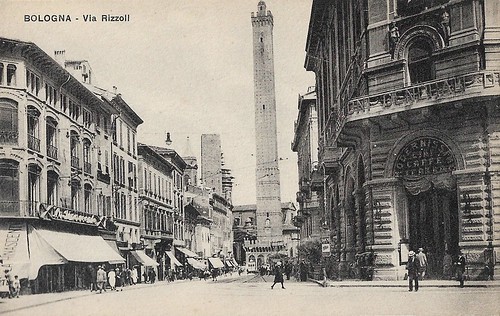
Italian postcard. Caption: Via Rizzoli, Bologna. 1920s.
While most people may recognise the two landmarks of Bologna in the back, the two medieval towers (remains of what once may have been a wood of towers all over town, similar to today's San Gimignano), we chose the card for the sign on the right over the entrance, spelling: 'Modernissimo, cine, caffè, teatro'. The whole block, called Palazzo Ronzani, was intended as a combination of commercial activities and leisure, so in addition to shops, offices, apartments, a cafe, a hotel, restaurant, and an underground theatre, it housed on the ground floor one of the finest cinemas in town: the Modernissimo. Plans were approved in 1912 but only in 1915 construction was finished. In recent years the Cineteca di Bologna has initiated to restore and restructure the Modernissimo into a 400 seat cinema, attempting as much as possible to restore the early 20th-century situation. See also Bologna magazine , Repubblica , and this picture at Flickr we took in 2017.
Sources: Jane Melichard (Cinepostcards), Cinema Treasures, De Filmkijker (Dutch), and Wikipedia.

French postcard by EAS, no. 08997/4. EAS stands for E.A. Schwerdtfeger, a German postcard publisher. Caption: Au Cinéma. Les plus jolis tableaux sont moins beaux que nos rêves (At the cinema. The most beautiful scenes are less beautiful than our dreams).

French postcard by M.D.(Phototypie Marcel Delboy, Bordeaux), no. 105. Caption: Saint-Jean-de-Luz, Le Casino.
A French poster for the silent comedy Rigadin et son sosie/Whiffle's Double (Georges Monca, Pathé Frères 1910), starring Prince. In front of the Casino, Saint-Jean-de-Luz, where the film apparently was shown.

American postcard by Mitock & Sons, North Hollywood, California. Color by Bert Kaltman / Plastichrome, Boston. The picture was taken at the premiere of It's a Mad Mad Mad Mad World (Stanley Kramer, 1963). This postcard was sent from Mexico to Italy. We bought it in the USA and it's now in our collection in the Netherlands.
Pacific's Cinerama Theatre is "The Only Theatre Of Its Kind In The World", boasts the card's publisher at the backside of the card. "Located in Cinerama Center, Sunset and Ivar, Hollywood, it's the first geodesic dome in concrete anywhere in the world. It is the first major theatre built in Hollywood in 35 years. It is an endless network of electronic marvels. Gold is the dominant color in the richly fabricated carpeting and drapes. Striking innovations in lightning and luxurious seating provide unbelievable comfort and beauty."

Vintage Czech postcard.
The former Mugrabi cinema (Kolnoa Mograbi) in Tel Aviv, Israël was located at the Kikar Bet BeNovember aka 'Mugrabi Square' near Allenby Road and Ben Yehuda Street. It was also known as Mograbi or Moograbi Opera House and as Mugrabi/Mograbi/Moograbi Hall. It was designed by architect Yosef Berlin in an art deco style that was popular in cinemas worldwide. The building was roofless for the first few years and was eventually stopped with a sliding roof. The cinema opened in 1930, and in the 1940s, it was home to the Palestine Folk Opera company. People gathered in front of the theater to dance in the streets when the UN General Assembly voted in favor of the Partition Plan in November 1947. Later it was again used as a cinema. It was a key cultural icon of Tel Aviv. If you wanted to locate yourself in the city, it was always in relation to the Mugrabi. After a fire in the summer of 1986 due to an electric short-circuit, the building was demolished. It is now a car park.

Dutch postcard. This picture of the former Rembrandt Theater in Amsterdam probably dates from 1932. That year the film Paprika was shown here. It was a German comedy directed by Carl Boese and starring the Hungarian star Franciska Gaal and German actor Paul Hörbiger. On the left side in the background, the postcard shows another famous Amsterdam cinema, the Tuschinski Theater.
The Rembrandt Theater was designed in Art Nouveau or Jugendstil style in 1902 by the architects Evert Breman and Willem Molenbroek. It started as a theatre for operettas but in 1919 it was renovated and changed into a cinema. There were 1200 seats. It became the main Dutch venue for the films of the German Ufa studio and many big billboards covered the front of the cinema. In 1940 the cinema suddenly burned down. Years later it was known that the fire was an act of the Dutch resistance. The cinema was never rebuilt and at the location at the Rembrandtplein (Rembrandt Square), 21-23 in the heart of Amsterdam is now a hotel.

Dutch photo. Front of the Rembrandt Theater in Amsterdam, The Netherlands. On show was Barcarole (Gerhard Lamprecht, 1936), starring Gustav Froehlich and Lyda Baarova. A gift by Roloff de Jeu.

Vintage postcard, no. 774. Grauman's Chinese Theatre, Los Angeles, USA.
Grauman's Chinese Theatre, now TCL Chinese Theatre, is a movie palace on the historic Hollywood Walk of Fame at 6925 Hollywood Blvd. in Hollywood, Los Angeles. The original Chinese Theatre was commissioned following the success of the nearby Grauman's Egyptian Theatre, which opened in 1922. Both are in Exotic Revival style architecture. Built by a partnership headed by Sid Grauman over 18 months starting in January 1926, the theatre opened 18 May 1927, with the premiere of Cecil B. DeMille's The King of Kings. It has since been home to many premieres. Among the theatre's most distinctive features are the concrete blocks set in the forecourt, which bear the signatures, footprints, and handprints of popular motion picture personalities from the 1920s to the present day. The in 2013 renovated theatre seats 932 people and features one of the largest movie screens in North America.

Longshaw Card Co., Los Angeles. Hollywood Boulevard around 1950.
This card was mailed in 1950. Left Grauman's Chinese Theatre. To the right the El Capitan cinema with the sign on the roof. In the middle, the high tower of the First National Bank (1928) by architects Meyer and Holler, still existing. The front right might be the entrance to the Roosevelt Hotel.

German postcard by Krüger, no. 921/10.
We once visited Zoo Palast, when it used to be one of the locations for the Berlin Film Festival. In 2011, the legendary cinema at the Hardenbergstraße in West-Berlin was closed. It was quite a shock to read this on Wikipedia. The Zoo Palast was built in 1956, but at the site, there had been a Palasttheater am Zoo since 1915. In 1925 the Ufa overtook and rebuilt the cinema. Many classics of the German film had their premiere here, including Metropolis in 1927. The cinema had its own orchestra, a ballet, and a cinema organ.

Dutch postcard by A. de Herder, Rotterdam. The Arena Cinema was located at the Kruiskade, Rotterdam, The Netherlands. The presented film was the Dutch comedy Fanfare (Bert Haanstra, 1958), starring Hans Kaart.
After the success with his W.B Theater on the Nieuwe Binnenweg, Karl Weisbard decided in 1930 to open a second cinema on the Kruiskade: Roxy Theater. The building was designed by Jac Van Gelderen. The cinema had 1000 seats and opened on 31 May 1930. In addition to films, small operettas were performed. In 1936, Karl Weisband sold the theatre to Ed Spits who converted it into Arena. During the war, only theatre performances took place, but from 1945 the showing of films was resumed. In 1988 Arena changed into the disco/music venue Nighttown, which went bankrupt in 2006. Since 2013, it is a supermarket.

Dutch postcard, Sparo. Rotterdam, Kruiskade with Luxor cinema.
Cinema Luxor in Rotterdam, The Netherlands, was built in 1917 by architect P.J. Vermaas and could hold 1200 seats then. It was the first really big film theatre in town. Luxor opened with the Dutch film Gloria Transita by Johan Gildemeijer. It was an opera film with live song performances by renowned Dutch singers such as Louis Morisson and Emil van Bosch. Around 1918-1919 it became a Dutch film theatre for the German Ufa films, that's why there are the German letters 'Palast' German for Palace) on the facade. The takeover was first secretly done by middlemen as Germany had lost the war of 1914-1918, but by 1926 the Dutch branch of the Ufa company became officially proprietor (until 1938).In 1928 Luxor was remodelled by architect J. van Wijngaarden. Luxor miraculously survived the Rotterdam bombardment and subsequent fires of May 1940. After the war, it was for years property of the Rotterdamsche Kunststichting (the Rotterdam Art Council), who ran it as a cinema, but slowly it became more and more mixed with theatre and Vaudeville. In the early 1970s, Luxor got a radical make-over, losing most if its old elements; the number of chairs went down to 900. Luxor closed down as a cinema in 1985.

American postcard. Times Square at Night, New York City, c. 1940-1941.
Down at left the marquee of the Astor Theatre indicates that Chaplin's The Great Dictator was screened, which had its New York premiere on October 1940. The Astor opened in 1905 as a legitimate theatre but became mostly a cinema from 1925 on. Top left publicity for the play 'Life with Father' which opened on Broadway, New York, in 1939; it was turned into a film in 1947. Down at right Loew's State Theatre, where Gary Cooper can be seen in The Westerner (1940). Loew's State Theatre opened in 1921 and showed both Vaudeville and cinema.

French postcard by BLD, no. 1. Photo: C.M., Le Havre. Caption: Interior of the Normandie. The Elevators. In the back: The theatre/cinema.
When entering into service in 1935, the French ocean liner Normandie was the biggest and fastest ocean liner in the world. Despite its commercial misfortune (the French state heavily subsidised it), Normandie's novel design and lavish interiors in Art Déco and Streamline Moderne Style led many to consider her the greatest of ocean liners.

French postcard by A. Nieps edit. Caption: Camp de Mailly, Foyer-Cinéma.
Seen from the podium, the French army visiting a temporary cinema at Camp de Mailly, poses for the photographer. The photo was made during the First World War. Mark the military orchestra in the pit in the foreground, accompanying the silent films. Camp de Mailly was a training camp for the military, founded in 1902, and most active during the Great War, in particular for training and equipping the Russian expeditionary force in France.

French postcard, no. 1610. Caption: Rue Caulaincourt, Paris. Sent by mail in 1921.
This building was created 1898-1900 as the Hippodrome Montmartre. In 1911 film producer Léon Gaumont took it over, restyled it, and turned it into the Gaumont-Palace. With its supposed 3000 seats, it was the biggest cinema in the world then (mark the letters on the facade 'Le plus grand cinéma du monde'). The Gaumont company also had its headquarters here. In 1931 Gaumont built a completely new cinema on the site, which hosted seats for 6000 persons, and was well equipped for sound film. In the 1960s it was a major Cinerama cinema, but in the early 1970s it closed down and in 1973 it was destroyed. Only by speedy handling, the French Cinematheque managed to save Leon Gaumont's personal archive, as workers had fast thrown outside all that was in the building. A vast part of the business archive thus must have been gone lost.

French postcard. Mourmelon-le-Grand (Marne), church and main square, left the cinema Tivoli and Salle des Fêtes. Probably 1920s.

French postcard by Librairie Militaire Guérin, Nourmelon-Le-Grand. Sent by mail in 1932. Tivoli Cinema, Mourmelon-Le-Grand, France.
The Tivoli Cinema was opened in 1932, according to the great database Cinema Treasures. It operated into at least the 1950s. It has since been demolished and apartments have been built on the site. However, Gerald A. DeLuca comments at the site: "Judging from the postcards, this is probably a pre-World War I cinema. The color-tinted one shows a poster for the film Sans famille, probably the 1913 version rather than the 1925 version." We agree with Gerald.

A picture of the Astor cinema in Vanderbijlpark, a city in Transvaal in South-Africa. The photo was sent as a postcard by a kid to his grandparents in the Netherlands. Maybe he is the kid standing in front of the cinema at the right?
Today, Vanderbijlpark town doesn't have a cinema anymore. Our sources, like Cinema Treasures, don't mention this cinema, but this photo of the Astor proves there used to be a cinema in Vanderbijlpark, once at a time.

French postcard, no. 93. Photo: Nam Phat, Saigon. Saïgon, Rue Catinal, Passage Eden, Cinema Eden.
The Eden building in Saigon (now Ho Chi Minh City), Vietnam, was built in 1947 and demolished in 2010, to make a place for a mall. The complex hosted the much older Cinema Eden, which in the 1920s was frequented by Europeans but later on was a popular hotspot for the Vietnamese population.

Polish postcard by Krajowa Agencja Wydawnicza. Photo: J. Tymínski - KAW. Kino Milenium, Slupsk, Poland.
Cinema Milenium in Słupsk - the name points to the future of cinematography - opened in 1963. It was one of the first in Poland to have a Cinerama. It belonged to the ten most important cinemas in Poland. The cinema inaugurated its activity on 4 April 1963 with a screening of the Polish film Zerwany most (Jerzy Passendorfer, 1962). Initially, the Milenium cinema had 724 seats in the auditorium, but their number decreased slightly after subsequent renovations and as a result of enlarging the stage. At the beginning of the 1970s, the number of seats was reduced to 640, in 1979 the reclining seats were replaced with new ones, and in 1999 another renovation and modernisation of the stage forced the number of seats to be reduced to 600. On 16 December 2000, the cinema showed its last film: Zerwany most. Now there is a supermarket in this building.

American postcard. Los Angeles, 7th Street/Hill Street, Warner Bros. Theatre Downtown.
Originally opened in 1920 as the Pantages Theatre, it later became the Downtown Warner Theatre (until the mid-1960s) and lastly the Warren Theatre (late 1960s and 1970s). Later a church, now a retail shop for the Jewelry Exchange. While the ground floor and podium disappeared, the proscenium arch balcony and ceiling are still there. No pictures allowed inside, but visitable with the Conservancy tour. See our Flickr site for a snapshot we took in 2010.

Italian postcard, no. 86. Venice, Lido, Palazzo del Cinema (left) and Casino (right), 1950s.
The Palazzo del Cinema was constructed in 1937 in record time to host the 5th edition of the Venice Film Festival. The architect was Luigi Quagliata, while next door Luigi Miozzi constructed the Summer Casino of Venice. In recent years the Palazzo del Cinema has expanded in several ways and also annexed the space of the Casino. Yet, the very ambitious plans for total makeover and demolition of existing structures mostly failed, over and again.

Italian postcard by Fotocelere. Caption: Sassuolo - Supercinema "Cristallo" - Interno.
The interior of the Supercinema Cristallo in Sassuolo in the province of Modena, Italy, probably in the 1950s. The cinema closed and was demolished.

French postcard by ND Phot., no. 358. Caption: Tunis, The Italian Theatre. The card was mailed in 1915.
The Politeama Rossini in Tunis was indicated here as The Italian Theatre. Politeama was an Italian denomination for a multifunctional entertainment building, combing cinema, theater, and other forms of leisure. The Politeama Rossini in Tunis opened in 1903. It catered to the Italian community in Tunis and competed with the City Theater, which had opened at the end of 1902. In 1923 it was sold and became storage. Later on, it became a cinema only. It still exists as the cinema Le Palace. Its facade was reconstructed in 2002 after it was destroyed during the embellishment of Avenue Bourguiba.

American postcard by E.C. Kropp Co., Milwaukee, no. 18088. Caption: "Jones, Linick & Schaefer's Rialto Theatre, State St., between Jackson and Van Buren. Finest Vaudeville Theatre in Chicago."
The Rialto Theatre in Chicago, Il., USA, was opened in 1917 as a venue for Vaudeville and films, near the corner of State and Van Buren Streets in Chicago. The Rialto could seat over 1500. The theatre was designed by the architectural duo of Marshall & Fox, who also designed the earlier legitimate Blackstone Theatre (now the Merle Reskin), the Blackstone Hotel, and, later, Chicago's famed Drake Hotel. This mid-sized venue was located directly across the street from the neo-classical department store building that began its life as Rothschild's, then the Davis Store, then Goldblatt's and is today the Loop campus of DePaul University. Later the Rialto Theatre was called the Loop End and still later, the Downtown, the Rialto was a burlesque house by the 1930s. In fact, it was the big burlesque center of Chicago for many years, save 1944-1950. Among the ladies who appeared onstage here were Gypsy Rose Lee, Margie Hart, Tempest Storm, Ada Leonard, and Ann Corio. Abbott and Costello reportedly first met there, and Phil Silvers also performed. A 1954 Chicago Tribune article stated that the Rialto closed on 31 December 1953 and was demolished shortly thereafter to make way for a one-story 'taxpayer' shops complex. The final sign on the marquee? "Speedway Wrecking Company - The Greatest Stripper of Them All"!

Italian postcard. Caption: Via Rizzoli, Bologna. 1920s.
While most people may recognise the two landmarks of Bologna in the back, the two medieval towers (remains of what once may have been a wood of towers all over town, similar to today's San Gimignano), we chose the card for the sign on the right over the entrance, spelling: 'Modernissimo, cine, caffè, teatro'. The whole block, called Palazzo Ronzani, was intended as a combination of commercial activities and leisure, so in addition to shops, offices, apartments, a cafe, a hotel, restaurant, and an underground theatre, it housed on the ground floor one of the finest cinemas in town: the Modernissimo. Plans were approved in 1912 but only in 1915 construction was finished. In recent years the Cineteca di Bologna has initiated to restore and restructure the Modernissimo into a 400 seat cinema, attempting as much as possible to restore the early 20th-century situation. See also Bologna magazine , Repubblica , and this picture at Flickr we took in 2017.
Sources: Jane Melichard (Cinepostcards), Cinema Treasures, De Filmkijker (Dutch), and Wikipedia.
Published on March 26, 2021 23:00
March 25, 2021
Kai Wiesinger
German actor Kai Wiesinger (1966) has appeared in several German TV shows and films since 1992. In Comedian Harmonists (1997) he played singer Erwin Bootz.
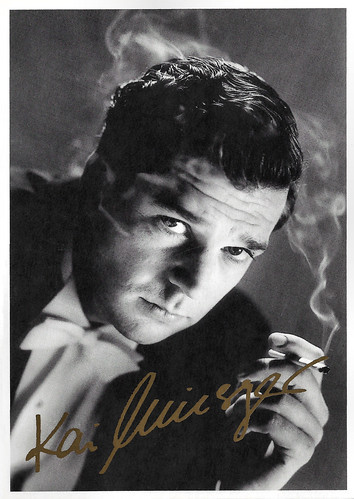
German postcard by Senator Film. Photo: Jim Rakete. Kai Wiesinger in Comedian Harmonists (Joseph Vilsmaier, 1997).
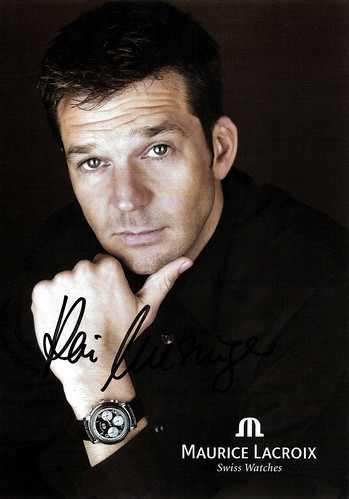
German autograph and promotion card by Maurice Lacroix Swiss Watches.
A chronicle of the rise and fall of Germany's most famous a capella group
Kai Wiesinger was born in 1966 in Hanover, West Germany. Wiesinger began taking private acting lessons as a teenager. During his Zivildienst he served as a paramedic. After that, he became an acting student in Munich.
In 1990, he made his stage debut in the role of Harold in 'Harold and Maude' at the Bavarian State Theater. Since 1992 he appeared in several German TV shows and films.
He received a Bavarian Film Award for his role in Sönke Wortmann's comedy Kleine Haie/Little Sharks (1992). Two years later, he appeared in the Anglo-German independent drama Backbeat (Ian Softley, 1994) a film on The Beatles ' formative period in Hamburg, starring Stephen Dorf and Ian Hart.
He then appeared in the hit comedy Der bewegte Mann/The Most Desired Man (Sönke Wortmann, 1994) starring Til Schweiger , Joachim Król, and Katja Riemann . The film was based on the comics by Ralf König.
He had a small part in the Norwegian film Pakten/Waiting for Sunset (Leidulv Risan, 1995), starring Robert Mitchum and Cliff Robertson. A huge success was Comedian Harmonists (Joseph Vilsmaier, 1997), which chronicles the rise and fall of Germany's most famous a capella group, the Comedian Harmonists, in 1930s Germany.
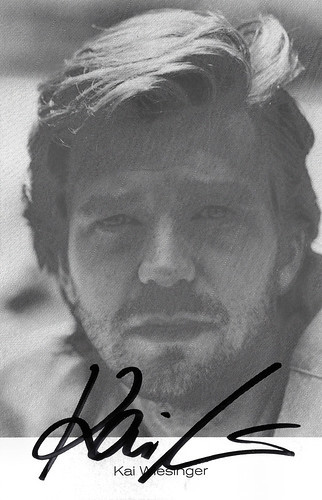
German autograph card.
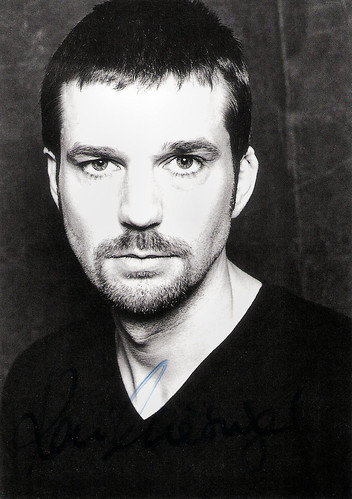
German autograph card by Rüdel-Verlag, Hamburg. Photo: Mathias Bothor.
The lawyer of the death angel of Auschwitz
Kai Wiesinger played the lawyer of Dr. Josef Mengele ( Götz George ), known as the "death angel of Auschwitz" in the film Nichts als die Wahrheit/After the Truth (Roland Suso Richter, 1999) depicting the fictional trial of Mengele.
In 2001 followed a role in the second most successful Austrian film of all time, Poppitz (Harald Sicheritz, 2002), together with Roland Düringer and Marie Bäumer.
He also played Emil's father in the family film Emil und die Detektive/Emil and the Detectives (Franziska Buch, 2001), based on the classic novel by Erich Kästner.
He had a small part in the Television mystery Murder on the Orient Express (Carl Schenkel, 2001) based on the novel by Agatha Christie, featuring Alfred Molina as Hercule Poirot.
The following year, he played in the Italian Mini-Series Dracula/Dracula's Curse (Roger Young, 2002), starring Patrick Bergin. Other notable screen appearances he had in the Mini-series Dresden (Roland Suso Richter, 2006), set during the bombing of Dresden in World War II, and the film Bis nichts mehr bleibt/Until Nothing Remains (Niki Klein, 2010) depicting a story about Scientology and its effects upon converts.
More recently he appeared in the films Lucky Loser - Ein Sommer in der Bredouille/Lucky Loser (Nico Sommer, 2017), and the comedy Takeover (Florian Ross, 2020).
From 1998 till her death in 2013, Kai Wiesinger was married to actress Chantal De Freitas. They had two children.
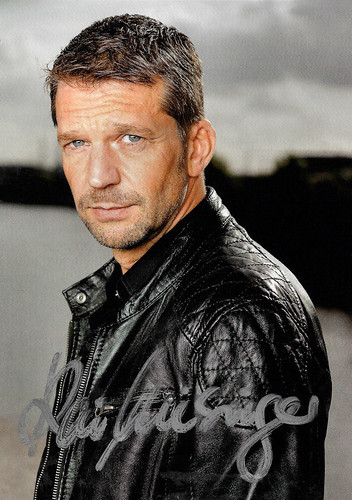
German autograph card. Photo: Thomas Leidig.
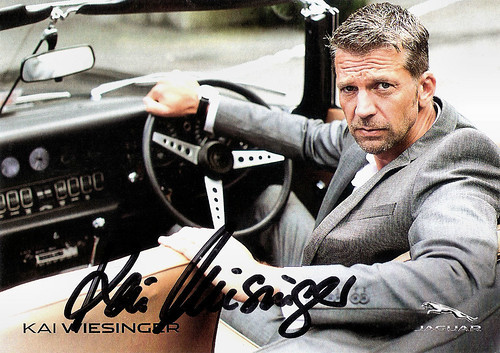
German autograph card by Jaguar.
Sources: Wikipedia and .

German postcard by Senator Film. Photo: Jim Rakete. Kai Wiesinger in Comedian Harmonists (Joseph Vilsmaier, 1997).

German autograph and promotion card by Maurice Lacroix Swiss Watches.
A chronicle of the rise and fall of Germany's most famous a capella group
Kai Wiesinger was born in 1966 in Hanover, West Germany. Wiesinger began taking private acting lessons as a teenager. During his Zivildienst he served as a paramedic. After that, he became an acting student in Munich.
In 1990, he made his stage debut in the role of Harold in 'Harold and Maude' at the Bavarian State Theater. Since 1992 he appeared in several German TV shows and films.
He received a Bavarian Film Award for his role in Sönke Wortmann's comedy Kleine Haie/Little Sharks (1992). Two years later, he appeared in the Anglo-German independent drama Backbeat (Ian Softley, 1994) a film on The Beatles ' formative period in Hamburg, starring Stephen Dorf and Ian Hart.
He then appeared in the hit comedy Der bewegte Mann/The Most Desired Man (Sönke Wortmann, 1994) starring Til Schweiger , Joachim Król, and Katja Riemann . The film was based on the comics by Ralf König.
He had a small part in the Norwegian film Pakten/Waiting for Sunset (Leidulv Risan, 1995), starring Robert Mitchum and Cliff Robertson. A huge success was Comedian Harmonists (Joseph Vilsmaier, 1997), which chronicles the rise and fall of Germany's most famous a capella group, the Comedian Harmonists, in 1930s Germany.

German autograph card.

German autograph card by Rüdel-Verlag, Hamburg. Photo: Mathias Bothor.
The lawyer of the death angel of Auschwitz
Kai Wiesinger played the lawyer of Dr. Josef Mengele ( Götz George ), known as the "death angel of Auschwitz" in the film Nichts als die Wahrheit/After the Truth (Roland Suso Richter, 1999) depicting the fictional trial of Mengele.
In 2001 followed a role in the second most successful Austrian film of all time, Poppitz (Harald Sicheritz, 2002), together with Roland Düringer and Marie Bäumer.
He also played Emil's father in the family film Emil und die Detektive/Emil and the Detectives (Franziska Buch, 2001), based on the classic novel by Erich Kästner.
He had a small part in the Television mystery Murder on the Orient Express (Carl Schenkel, 2001) based on the novel by Agatha Christie, featuring Alfred Molina as Hercule Poirot.
The following year, he played in the Italian Mini-Series Dracula/Dracula's Curse (Roger Young, 2002), starring Patrick Bergin. Other notable screen appearances he had in the Mini-series Dresden (Roland Suso Richter, 2006), set during the bombing of Dresden in World War II, and the film Bis nichts mehr bleibt/Until Nothing Remains (Niki Klein, 2010) depicting a story about Scientology and its effects upon converts.
More recently he appeared in the films Lucky Loser - Ein Sommer in der Bredouille/Lucky Loser (Nico Sommer, 2017), and the comedy Takeover (Florian Ross, 2020).
From 1998 till her death in 2013, Kai Wiesinger was married to actress Chantal De Freitas. They had two children.

German autograph card. Photo: Thomas Leidig.

German autograph card by Jaguar.
Sources: Wikipedia and .
Published on March 25, 2021 23:00
March 24, 2021
Gary Oldman
Gary Oldman (1958) is a talented English film star and character actor, renowned for his expressive acting style. He is one of the most celebrated thespians of his generation, with a diverse career encompassing theatre, film, and television. Oldman is known for his roles as Sid Vicious in Sid and Nancy (1986), Drexl in True Romance (1993), George Smiley in Tinker Tailor Soldier Spy (2011), and Winston Churchill in Darkest Hour (2017).
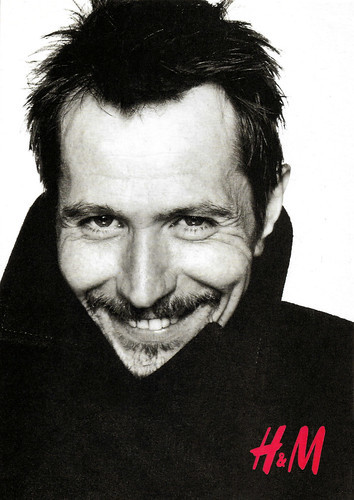
Dutch postcard by Boomerang Freecards for H & M, no. P 20-98.
Best Newcomer as Sex Pistol Sid Vicious
Gary Leonard Oldman was born in 1958 in New Cross, London, England, to Kathleen (Cheriton), a homemaker, and Leonard Bertram Oldman, a welder.
He won a scholarship to Britain's Rose Bruford Drama College, in Sidcup, Kent, where he received a B.A. in theatre arts in 1979. He subsequently studied with the Greenwich Young People's Theatr.
Oldman went on to appear in a number of plays throughout the early 1980s, including 'The Pope's Wedding', for which he received Time Out's Fringe Award for Best Newcomer of 1985-1986 and the British Theatre Association's Drama Magazine Award as Best Actor for 1985
Before fame, he was employed as a worker in assembly lines, and as a porter in an operating theatre. He also got jobs selling shoes and beheading pigs while supporting his early acting career.
His film debut was Remembrance (Colin Gregg, 1982), though his most-memorable early role came when he played Sex Pistol Sid Vicious in the biopic Sid and Nancy (Alex Cox, 1986) picking up the Evening Standard Film Award as Best Newcomer.
He then received a Best Actor nomination from BAFTA for his portrayal of 1960s playwright Joe Orton in Prick Up Your Ears (Stephen Frears, 1987).
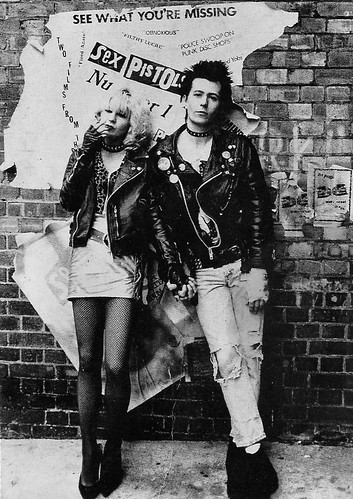
French postcard by Humour à la Carte, Paris, no. A-C 656. Gary Oldman as Sid Vicious and Chloe Webb as Nancy Spungen in Sid and Nancy (Alex Cox, 1986). Sent by mail in 1987.
Iconic real-world and fictional villains
In the 1990s, Gary Oldman brought to life a series of iconic real-world and fictional villains including Lee Harvey Oswald in JFK (Oliver Stone, 1991), the title character in Bram Stoker's Dracula (Francis Coppola, 1992), Drexl Spivey in True Romance (Tony Scott, 1993), Stansfield in Léon (Luc Besson, 1994), Jean-Baptiste Emanuel Zorg in The Fifth Element (Luc Besson, 1997) and Ivan Korshunov in Air Force One (Wolfgang Petersen, 1997).
That decade also saw Oldman portraying Ludwig van Beethoven in the biopic Immortal Beloved (Bernard Rose, 1994) with Jeroen Krabbé .
Oldman tried his hand at writing and directing for Nil by Mouth (Gary Oldman, 1997), starring Ray Winstone and Kathy Burke. The film is loosely based upon his own life growing up in London. Nil by Mouth opened the Cannes Film Festival in 1997 and won Kathy Burke a Best Actress prize at the festival.
Gary Oldman's problems with alcohol were well known during the early 1990s: he checked himself into rehab for alcoholism treatment in 1995. In subsequent interviews, Oldman acknowledged his problems with alcohol and called himself a recovering alcoholic in a 2001 interview with Charlie Rose.
Oldman now lives a teetotal lifestyle and attributes his success in beating his addiction to attending meetings with Alcoholics Anonymous, whom he has publicly praised.
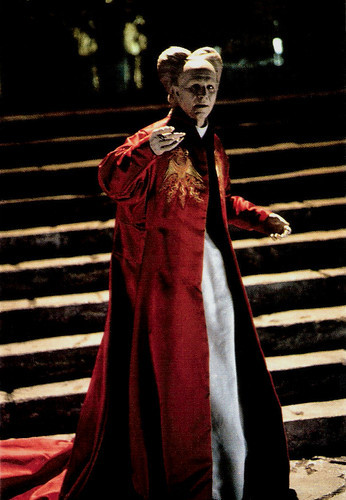
American postcard by Classico, San Francisco, no. 244-008. Photo: Columbia Pictures. Gary Oldman in Dracula (Francis Coppola, 1992).
The coveted role of Sirius Black
Gary Oldman played Mason Verger in Hannibal (Ridley Scott, 2001), starring Anthony Hopkins. He then played the coveted role of Sirius Black in Harry Potter and the Prisoner of Azkaban (Alfonso Cuarón, 2004), giving him a key part in one of the highest-grossing franchises ever.
He reprised that role in Harry Potter and the Goblet of Fire (Mike Newell, 2005) and Harry Potter and the Order of the Phoenix (David Yates, 2007).
Oldman also took on the iconic role of Detective James Gordon in writer-director Christopher Nolan's Batman Begins (2005), starring Christian Bale. He played the role again in The Dark Knight (Christopher Nolan, 2008) and The Dark Knight Rises (Christopher Nolan, 2012).
Film critic Mark Kermode, in reviewing The Dark Knight, wrote: "the best performance in the film, by a mile, is Gary Oldman's ... it would be lovely to see him get a[n Academy Award] nomination because actually, he's the guy who gets kind of overlooked in all of this."
Oldman co-starred with Jim Carrey in a new version of A Christmas Carol (Robert Zemeckis, 2009) in which Oldman played three roles. He had a starring role in David Goyer's supernatural thriller The Unborn (2009).
In 2010, Oldman co-starred with Denzel Washington in The Book of Eli (The Hughes Brothers, 2010). He also played a lead role in Catherine Hardwicke's Red Riding Hood (Catherine Hardwicke, 2011), featuring Amanda Seyfried. Oldman voiced the role of villain Lord Shen in Kung Fu Panda 2 (Jennifer Yuh Nelson, 2011) and was nominated for an Annie Award for his performance.
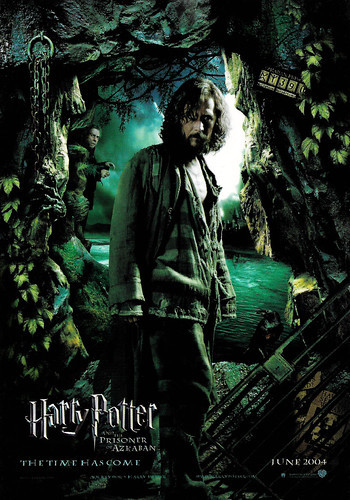
French postcard by Sonis, no. C. 1519. Photo: Warner Bros. Gary Oldman in Harry Potter and the Prisoner of Azkaban (Alfonso Cuarón, 2004). Caption: The time has come. June 2004.
The scientist who creates RoboCop
In 2011, Gary Oldman portrayed master spy George Smiley in the adaptation of John le Carré's Tinker Tailor Soldier Spy (Tomas Alfredson, 2011), and the role scored Oldman his first Oscar nomination.
In 2014, Oldman starred alongside Joel Kinnaman, Abbie Cornish, Michael Keaton, and Samuel L. Jackson in the remake of RoboCop (José Padilha, 2014), as Norton, the scientist who creates RoboCop.
Also that year, Oldman played one of the lead humans in the Science Fiction action film Dawn of the Planet of the Apes (Matt Reeves, 2014) alongside Jason Clarke and Keri Russell.
In 2018 he won an Oscar for best actor for his work on Darkest Hour (Joe Wright, 2017). Last year, he won accolades for his portrayal of alcoholic screenwriter Herman J. Mankiewicz in Mank (David Fincher, 2020).
Gary Oldman married five times. His first four marriages were to actress Lesley Manville, film star Uma Thurman, Donya Fiorentino, and Alexandra Edenborough. They all ended in a divorce. Since 2017, he is married to writer and art curator Gisele Schmidt. Oldman has three sons: Alfie Oldman (1988) from his first marriage to Lesley Manville, Gulliver Flynn Oldman (1997), and Charlie John Oldman (1999) with Donya Fiorentino.
[image error]
British postcard by Heroes Publishing Ltd, London, no. SPC 2788. Photo: publicity still for True Romance (Tony Scott, 1993).
Trailer for Mank (David Fincher, 2020). Source: Netflix (YouTube).
Sources: Wikipedia and .

Dutch postcard by Boomerang Freecards for H & M, no. P 20-98.
Best Newcomer as Sex Pistol Sid Vicious
Gary Leonard Oldman was born in 1958 in New Cross, London, England, to Kathleen (Cheriton), a homemaker, and Leonard Bertram Oldman, a welder.
He won a scholarship to Britain's Rose Bruford Drama College, in Sidcup, Kent, where he received a B.A. in theatre arts in 1979. He subsequently studied with the Greenwich Young People's Theatr.
Oldman went on to appear in a number of plays throughout the early 1980s, including 'The Pope's Wedding', for which he received Time Out's Fringe Award for Best Newcomer of 1985-1986 and the British Theatre Association's Drama Magazine Award as Best Actor for 1985
Before fame, he was employed as a worker in assembly lines, and as a porter in an operating theatre. He also got jobs selling shoes and beheading pigs while supporting his early acting career.
His film debut was Remembrance (Colin Gregg, 1982), though his most-memorable early role came when he played Sex Pistol Sid Vicious in the biopic Sid and Nancy (Alex Cox, 1986) picking up the Evening Standard Film Award as Best Newcomer.
He then received a Best Actor nomination from BAFTA for his portrayal of 1960s playwright Joe Orton in Prick Up Your Ears (Stephen Frears, 1987).

French postcard by Humour à la Carte, Paris, no. A-C 656. Gary Oldman as Sid Vicious and Chloe Webb as Nancy Spungen in Sid and Nancy (Alex Cox, 1986). Sent by mail in 1987.
Iconic real-world and fictional villains
In the 1990s, Gary Oldman brought to life a series of iconic real-world and fictional villains including Lee Harvey Oswald in JFK (Oliver Stone, 1991), the title character in Bram Stoker's Dracula (Francis Coppola, 1992), Drexl Spivey in True Romance (Tony Scott, 1993), Stansfield in Léon (Luc Besson, 1994), Jean-Baptiste Emanuel Zorg in The Fifth Element (Luc Besson, 1997) and Ivan Korshunov in Air Force One (Wolfgang Petersen, 1997).
That decade also saw Oldman portraying Ludwig van Beethoven in the biopic Immortal Beloved (Bernard Rose, 1994) with Jeroen Krabbé .
Oldman tried his hand at writing and directing for Nil by Mouth (Gary Oldman, 1997), starring Ray Winstone and Kathy Burke. The film is loosely based upon his own life growing up in London. Nil by Mouth opened the Cannes Film Festival in 1997 and won Kathy Burke a Best Actress prize at the festival.
Gary Oldman's problems with alcohol were well known during the early 1990s: he checked himself into rehab for alcoholism treatment in 1995. In subsequent interviews, Oldman acknowledged his problems with alcohol and called himself a recovering alcoholic in a 2001 interview with Charlie Rose.
Oldman now lives a teetotal lifestyle and attributes his success in beating his addiction to attending meetings with Alcoholics Anonymous, whom he has publicly praised.

American postcard by Classico, San Francisco, no. 244-008. Photo: Columbia Pictures. Gary Oldman in Dracula (Francis Coppola, 1992).
The coveted role of Sirius Black
Gary Oldman played Mason Verger in Hannibal (Ridley Scott, 2001), starring Anthony Hopkins. He then played the coveted role of Sirius Black in Harry Potter and the Prisoner of Azkaban (Alfonso Cuarón, 2004), giving him a key part in one of the highest-grossing franchises ever.
He reprised that role in Harry Potter and the Goblet of Fire (Mike Newell, 2005) and Harry Potter and the Order of the Phoenix (David Yates, 2007).
Oldman also took on the iconic role of Detective James Gordon in writer-director Christopher Nolan's Batman Begins (2005), starring Christian Bale. He played the role again in The Dark Knight (Christopher Nolan, 2008) and The Dark Knight Rises (Christopher Nolan, 2012).
Film critic Mark Kermode, in reviewing The Dark Knight, wrote: "the best performance in the film, by a mile, is Gary Oldman's ... it would be lovely to see him get a[n Academy Award] nomination because actually, he's the guy who gets kind of overlooked in all of this."
Oldman co-starred with Jim Carrey in a new version of A Christmas Carol (Robert Zemeckis, 2009) in which Oldman played three roles. He had a starring role in David Goyer's supernatural thriller The Unborn (2009).
In 2010, Oldman co-starred with Denzel Washington in The Book of Eli (The Hughes Brothers, 2010). He also played a lead role in Catherine Hardwicke's Red Riding Hood (Catherine Hardwicke, 2011), featuring Amanda Seyfried. Oldman voiced the role of villain Lord Shen in Kung Fu Panda 2 (Jennifer Yuh Nelson, 2011) and was nominated for an Annie Award for his performance.

French postcard by Sonis, no. C. 1519. Photo: Warner Bros. Gary Oldman in Harry Potter and the Prisoner of Azkaban (Alfonso Cuarón, 2004). Caption: The time has come. June 2004.
The scientist who creates RoboCop
In 2011, Gary Oldman portrayed master spy George Smiley in the adaptation of John le Carré's Tinker Tailor Soldier Spy (Tomas Alfredson, 2011), and the role scored Oldman his first Oscar nomination.
In 2014, Oldman starred alongside Joel Kinnaman, Abbie Cornish, Michael Keaton, and Samuel L. Jackson in the remake of RoboCop (José Padilha, 2014), as Norton, the scientist who creates RoboCop.
Also that year, Oldman played one of the lead humans in the Science Fiction action film Dawn of the Planet of the Apes (Matt Reeves, 2014) alongside Jason Clarke and Keri Russell.
In 2018 he won an Oscar for best actor for his work on Darkest Hour (Joe Wright, 2017). Last year, he won accolades for his portrayal of alcoholic screenwriter Herman J. Mankiewicz in Mank (David Fincher, 2020).
Gary Oldman married five times. His first four marriages were to actress Lesley Manville, film star Uma Thurman, Donya Fiorentino, and Alexandra Edenborough. They all ended in a divorce. Since 2017, he is married to writer and art curator Gisele Schmidt. Oldman has three sons: Alfie Oldman (1988) from his first marriage to Lesley Manville, Gulliver Flynn Oldman (1997), and Charlie John Oldman (1999) with Donya Fiorentino.
[image error]
British postcard by Heroes Publishing Ltd, London, no. SPC 2788. Photo: publicity still for True Romance (Tony Scott, 1993).
Trailer for Mank (David Fincher, 2020). Source: Netflix (YouTube).
Sources: Wikipedia and .
Published on March 24, 2021 23:00
March 23, 2021
Joan Rice
Joan Rice (1930-1997) was a pert, dark-haired leading lady, who enjoyed a brief flurry of popularity in British films of the early- to mid-1950s. She is probably best known as Maid Marian to Richard Todd's Robin Hood in Disney's The Story of Robin Hood and His Merrie Men (1952) and as Dalabo in His Majesty O'Keefe (1954) with Burt Lancaster.

British postcard in the Picturegoer Series, London, no. W 955. Photo: J. Arthur Rank Organisation Ltd.
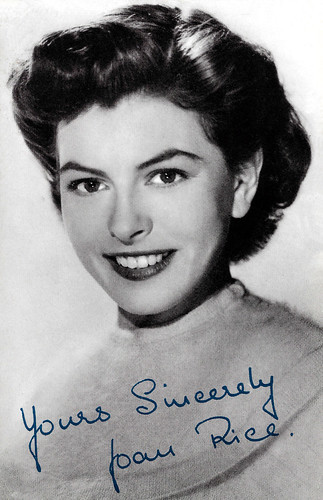
British postcard in the Film Star Autograph Portrait Series by L.D. Ltd., London, no. 64. Photo: J. Arthur Rank Organisation.
Trained at Rank's Charm School
Joan Rice was born in 1930 in Derby, Derbyshire, England. One of four sisters from a broken home, she spent eight years in a convent orphanage in Nottingham.
In 1949, upon arriving in London she first took a job as a waitress at Lyon's Restaurant in London. She was crowned "Miss Lyons, 1949" (or Miss Nippy - the sources differ), at an in-house beauty contest.
There she was introduced to the theatrical agent Joan Reese, who secured a screen test and a two-line bit part in the comedy, One Wild Oat. Thereafter, she trained at the Rank Organisation's "charm school".
Rice made her real screen debut in Blackmailed (Marc Allégret, 1950) with Dirk Bogarde and Mai Zetterling . She settled into demure, ornamental roles and for several years in the early and mid-1950s, Rice was considered one of 'Rank's top stars'.
In Disney's Anglo-American production The Story of Robin Hood (Ken Annakin, 1952), she was maid Marian opposite Richard Todd as Robin. In the drama A Day to Remember (Ralph Thomas, 1953), she appeared with Stanley Holloway.
Rice was Burt Lancaster 's vis-a-vis in His Majesty O'Keefe (Byron Haskin, 1954). She was also the leading lady in the comedy One Good Turn (John Paddy Carstairs, 1955), starring Norman Wisdom .
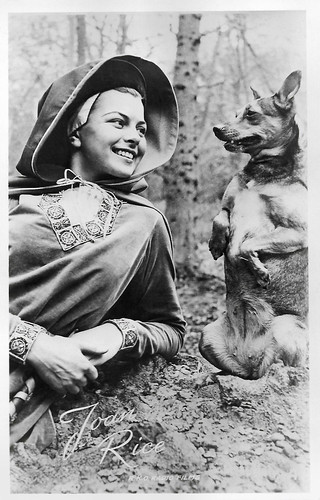
Dutch postcard by Takken / 't Sticht, no. 1283. Joan Rice in The Story of Robin Hood and His Merrie Men (Ken Annakin, 1952).
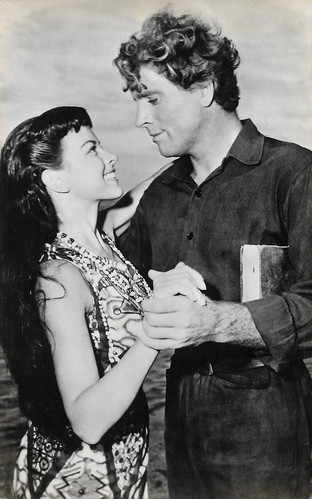
Spanish postcard by H. Burt Lancaster and Joan Rice in His Majesty O'Keefe (Byron Haskin, 1954). On the flipside is written that the actress is Ronda Fleming (sic).
The graverobber's wife in The Horror of Frankenstein
Joan Rice's last film was the crime drama Payroll (Sidney Hayers, 1961) with Michael Craig and Françoise Prévost before she retired from films.
In the 1970s, she made a comeback as a character actress and played the graverobber's wife in The Horror of Frankenstein (Jimmy Sangster, 1970) with Ralph Bates, Kate O'Mara, and Dennis Price as the Graverobber.
She operated an estate agency in Maidenhead, Berkshire. Joan Rice passed away in 1997 in Maidenhead, at the age of 66. Her interment was at Braywick Cemetery in Maidenhead.
Her first husband, from 1953 to 1964, was David Green, son of the American comedian, Harry Green. They had one son, Michael, who committed suicide. In 1984 she married former Daily Sketch journalist Ken McKenzie.
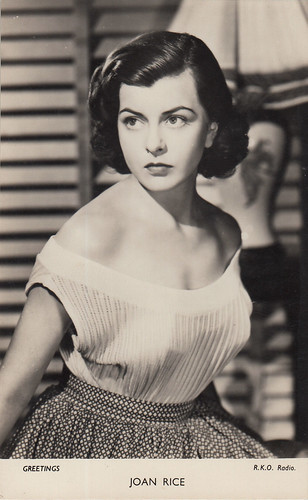
British postcard in the Greetings series. Photo: R.K.O. Radio. Collection: Marlene Pilaete.
Trailer for The Story of Robin Hood and His Merrie Men (1952) starring Richard Todd . Source: wwodtv (YouTube).
Sources: Hal Erickson (AllMovie), Find A Grave, Wikipedia, and .

British postcard in the Picturegoer Series, London, no. W 955. Photo: J. Arthur Rank Organisation Ltd.

British postcard in the Film Star Autograph Portrait Series by L.D. Ltd., London, no. 64. Photo: J. Arthur Rank Organisation.
Trained at Rank's Charm School
Joan Rice was born in 1930 in Derby, Derbyshire, England. One of four sisters from a broken home, she spent eight years in a convent orphanage in Nottingham.
In 1949, upon arriving in London she first took a job as a waitress at Lyon's Restaurant in London. She was crowned "Miss Lyons, 1949" (or Miss Nippy - the sources differ), at an in-house beauty contest.
There she was introduced to the theatrical agent Joan Reese, who secured a screen test and a two-line bit part in the comedy, One Wild Oat. Thereafter, she trained at the Rank Organisation's "charm school".
Rice made her real screen debut in Blackmailed (Marc Allégret, 1950) with Dirk Bogarde and Mai Zetterling . She settled into demure, ornamental roles and for several years in the early and mid-1950s, Rice was considered one of 'Rank's top stars'.
In Disney's Anglo-American production The Story of Robin Hood (Ken Annakin, 1952), she was maid Marian opposite Richard Todd as Robin. In the drama A Day to Remember (Ralph Thomas, 1953), she appeared with Stanley Holloway.
Rice was Burt Lancaster 's vis-a-vis in His Majesty O'Keefe (Byron Haskin, 1954). She was also the leading lady in the comedy One Good Turn (John Paddy Carstairs, 1955), starring Norman Wisdom .

Dutch postcard by Takken / 't Sticht, no. 1283. Joan Rice in The Story of Robin Hood and His Merrie Men (Ken Annakin, 1952).

Spanish postcard by H. Burt Lancaster and Joan Rice in His Majesty O'Keefe (Byron Haskin, 1954). On the flipside is written that the actress is Ronda Fleming (sic).
The graverobber's wife in The Horror of Frankenstein
Joan Rice's last film was the crime drama Payroll (Sidney Hayers, 1961) with Michael Craig and Françoise Prévost before she retired from films.
In the 1970s, she made a comeback as a character actress and played the graverobber's wife in The Horror of Frankenstein (Jimmy Sangster, 1970) with Ralph Bates, Kate O'Mara, and Dennis Price as the Graverobber.
She operated an estate agency in Maidenhead, Berkshire. Joan Rice passed away in 1997 in Maidenhead, at the age of 66. Her interment was at Braywick Cemetery in Maidenhead.
Her first husband, from 1953 to 1964, was David Green, son of the American comedian, Harry Green. They had one son, Michael, who committed suicide. In 1984 she married former Daily Sketch journalist Ken McKenzie.

British postcard in the Greetings series. Photo: R.K.O. Radio. Collection: Marlene Pilaete.
Trailer for The Story of Robin Hood and His Merrie Men (1952) starring Richard Todd . Source: wwodtv (YouTube).
Sources: Hal Erickson (AllMovie), Find A Grave, Wikipedia, and .
Published on March 23, 2021 23:00
Paul van Yperen's Blog
- Paul van Yperen's profile
- 13 followers
Paul van Yperen isn't a Goodreads Author
(yet),
but they
do have a blog,
so here are some recent posts imported from
their feed.



